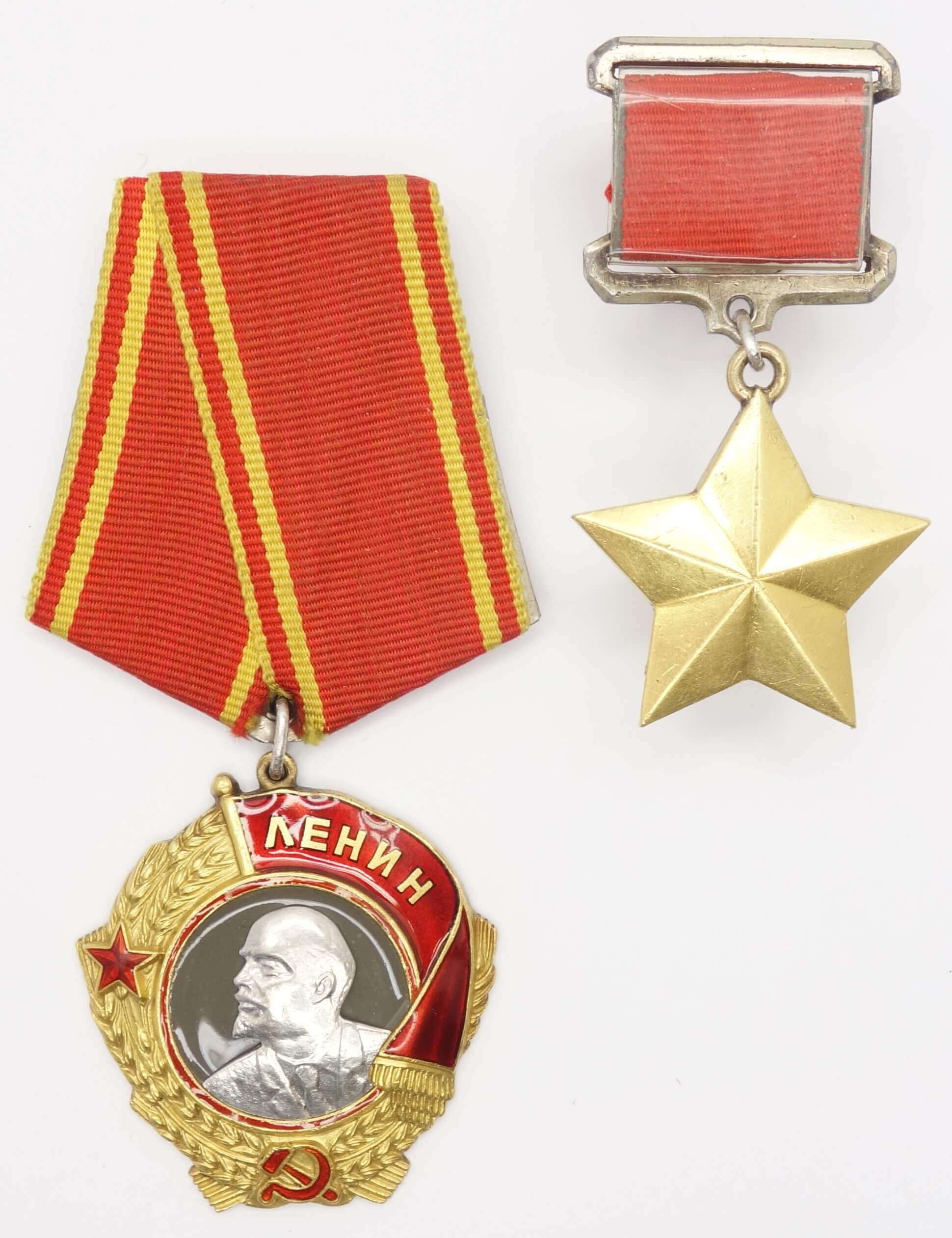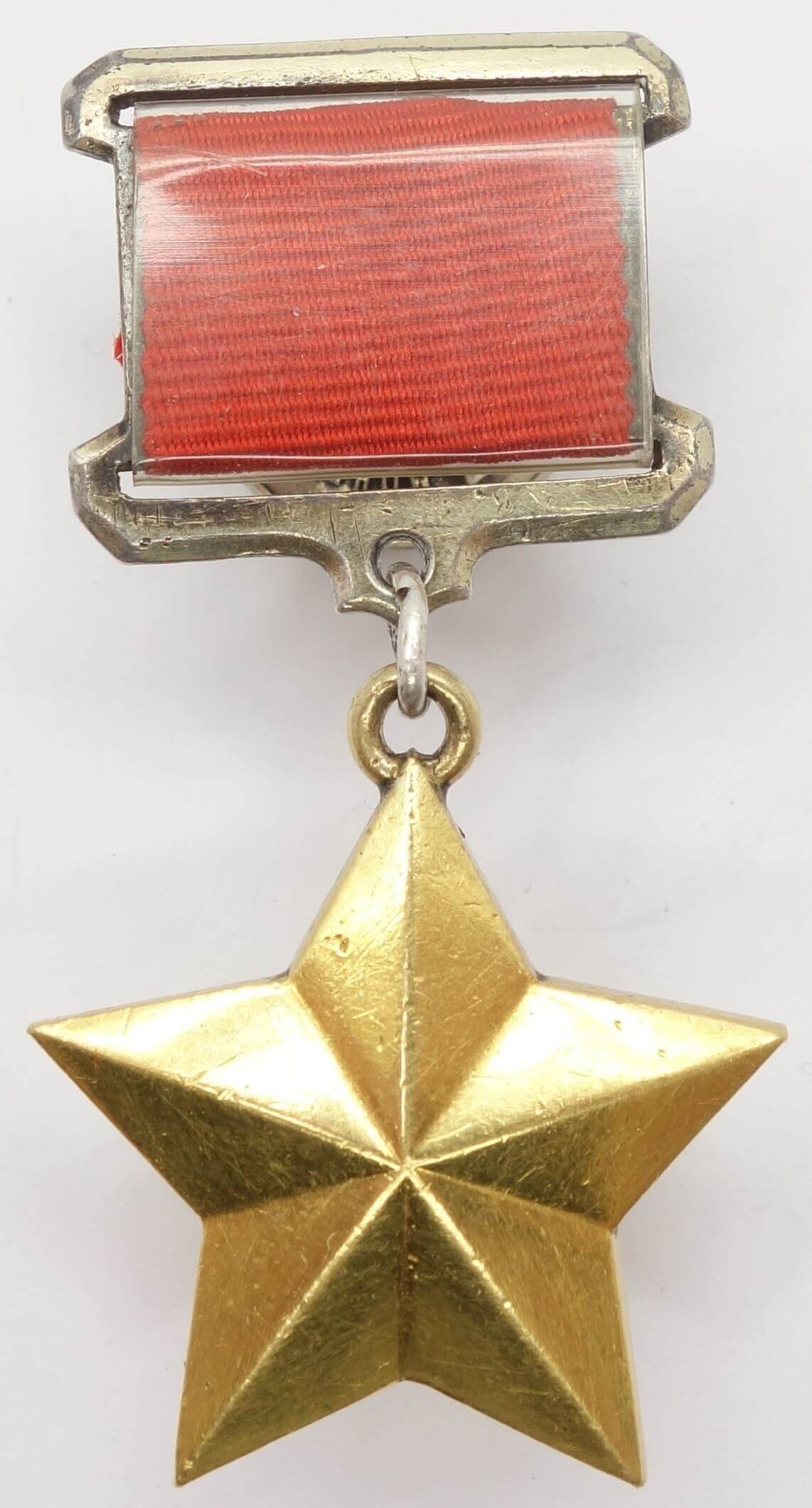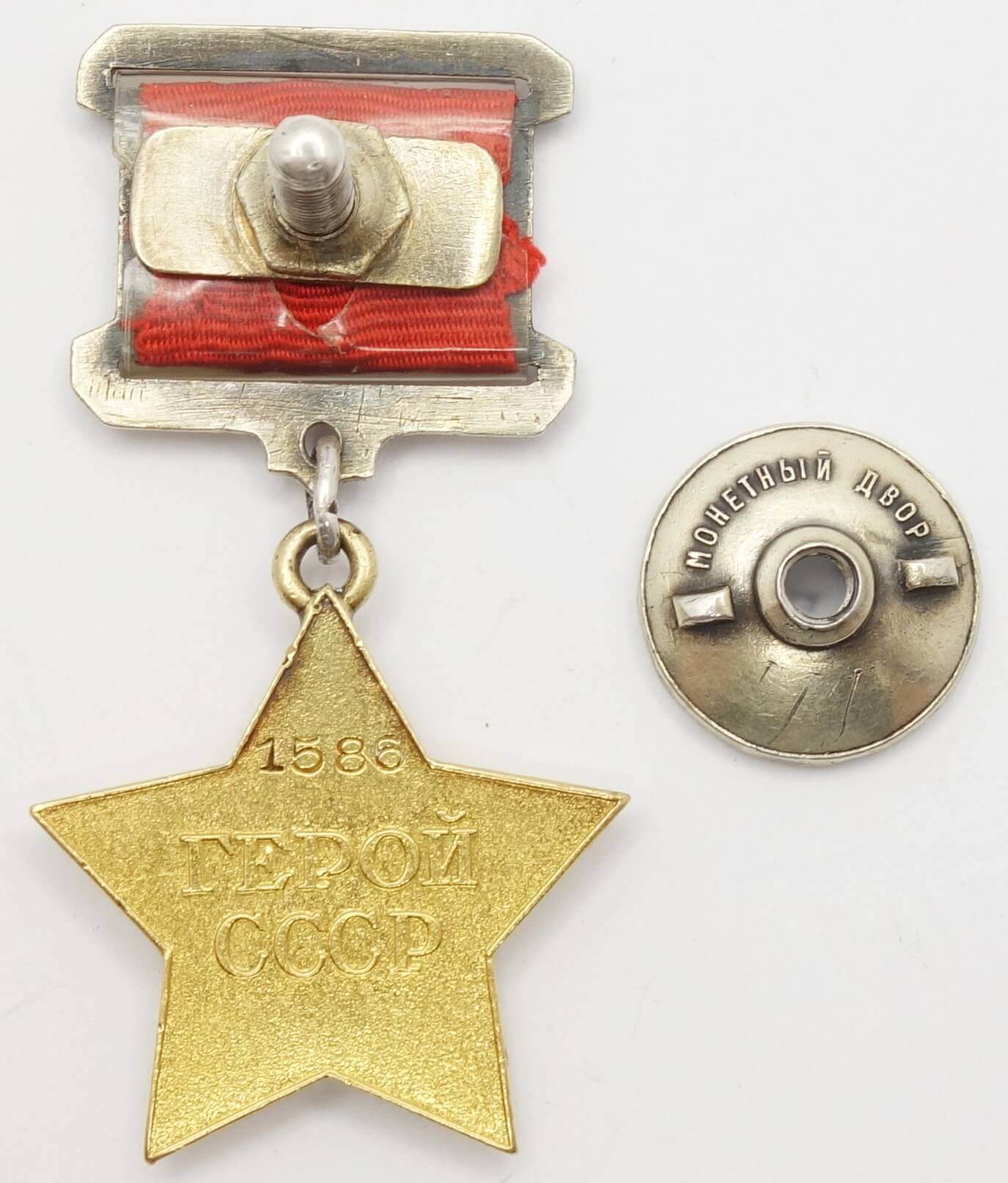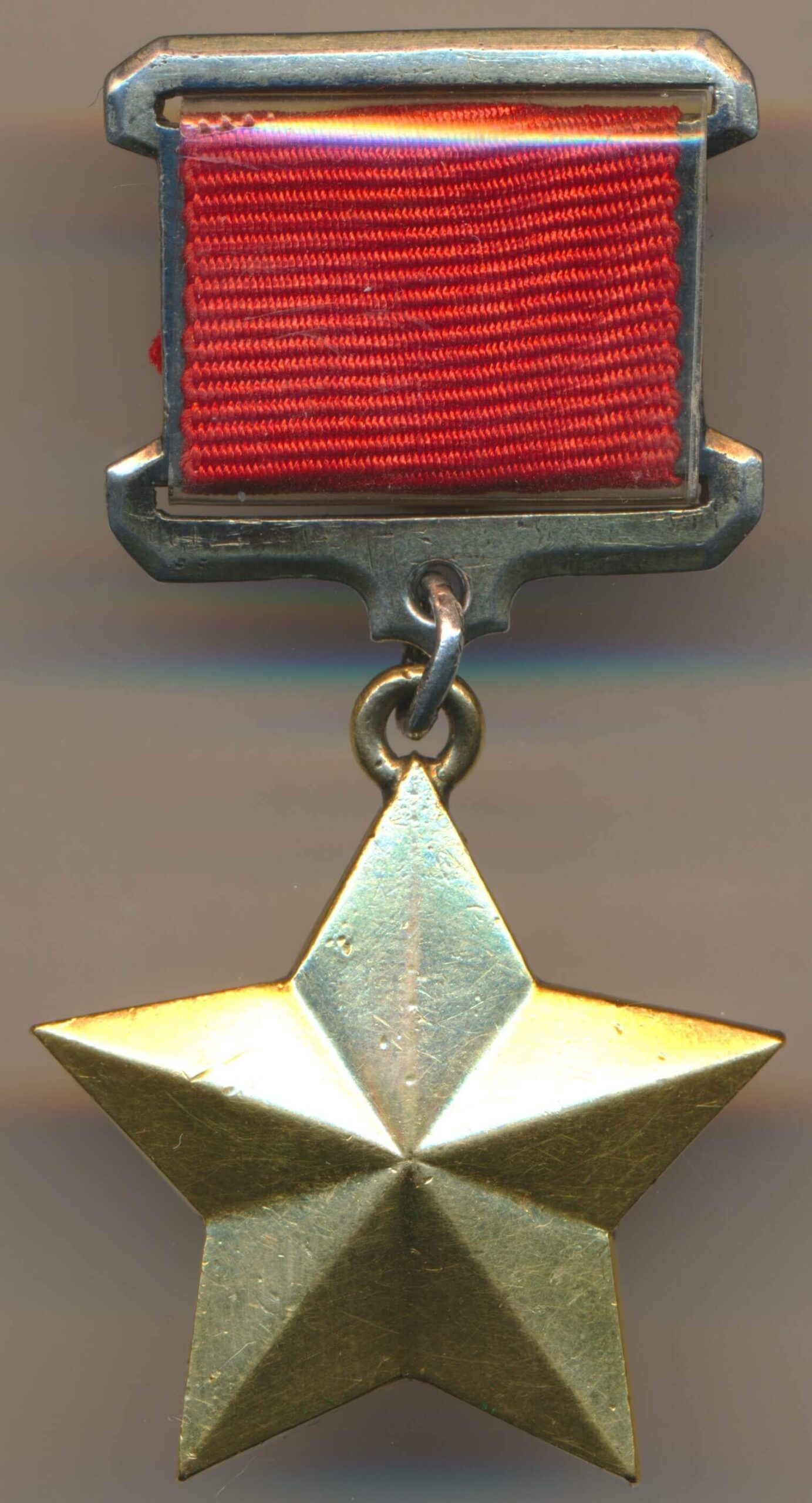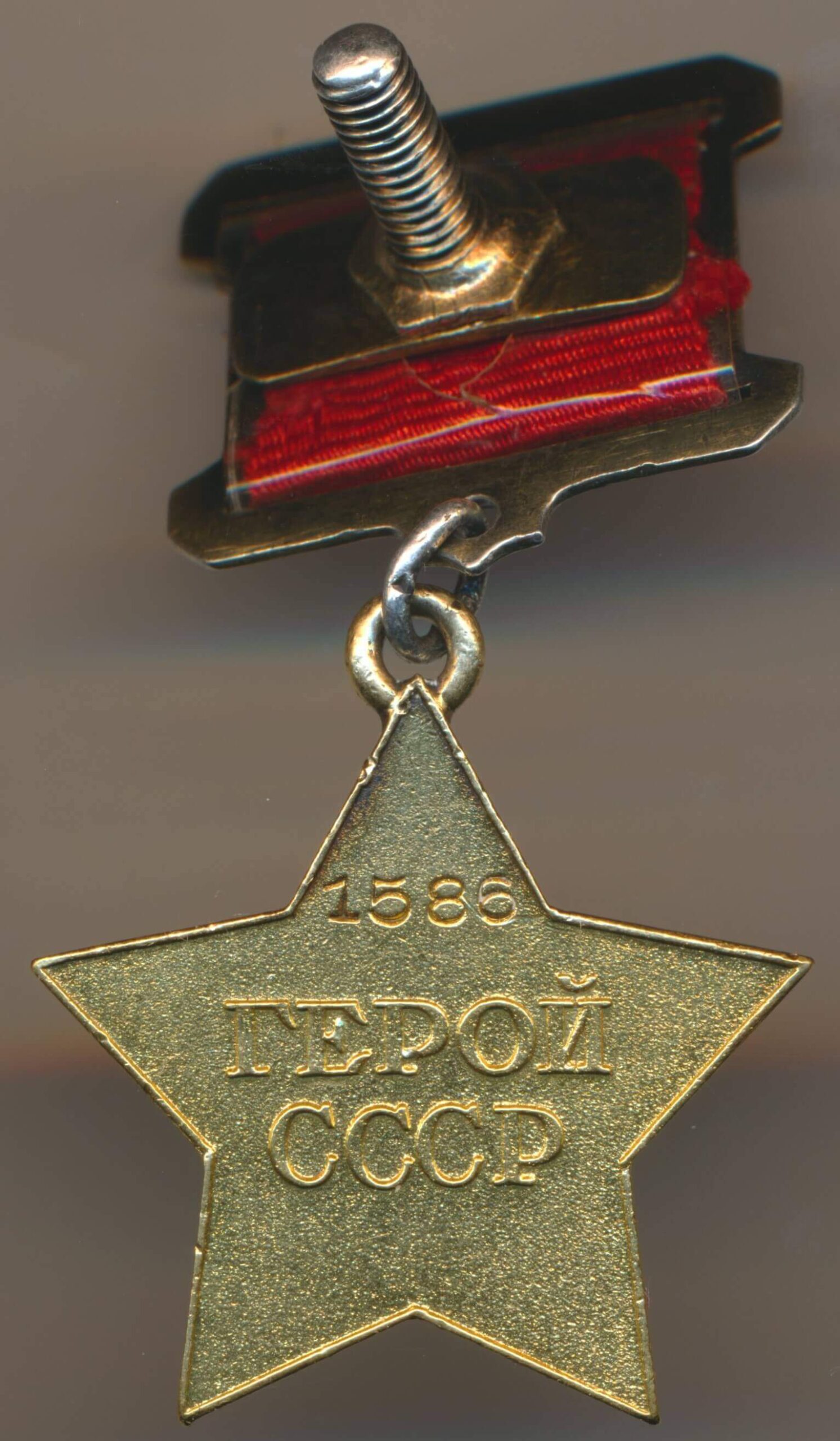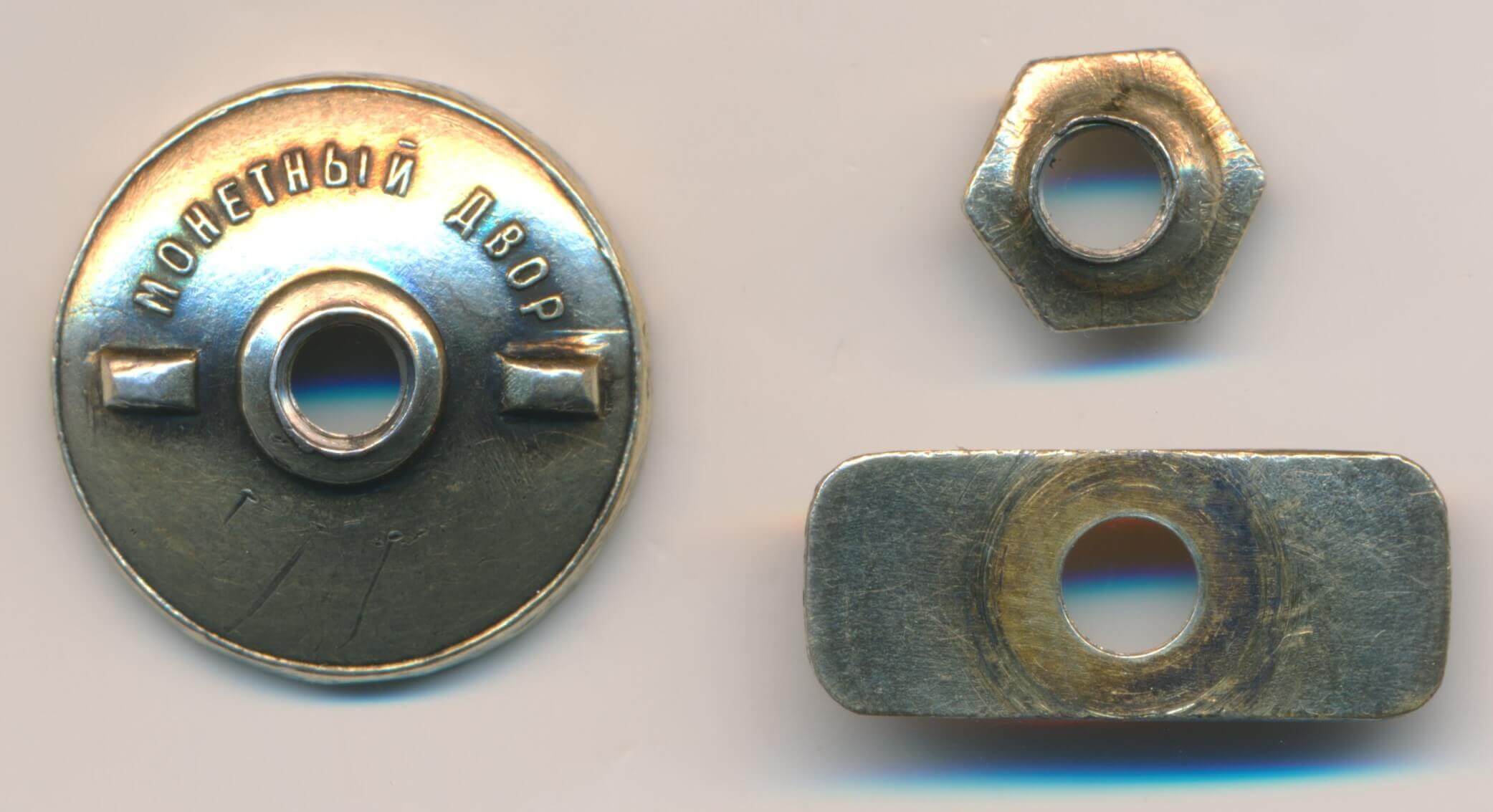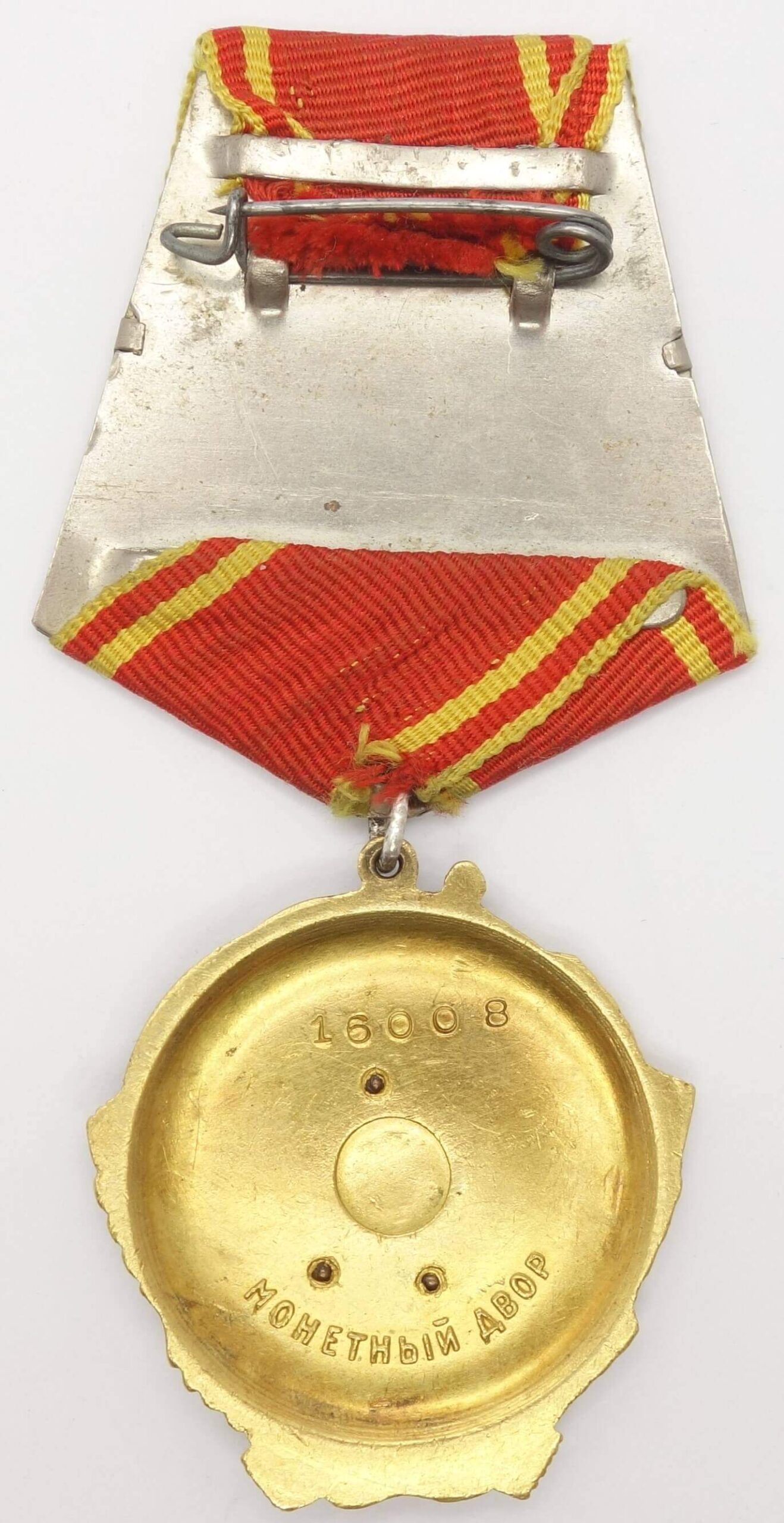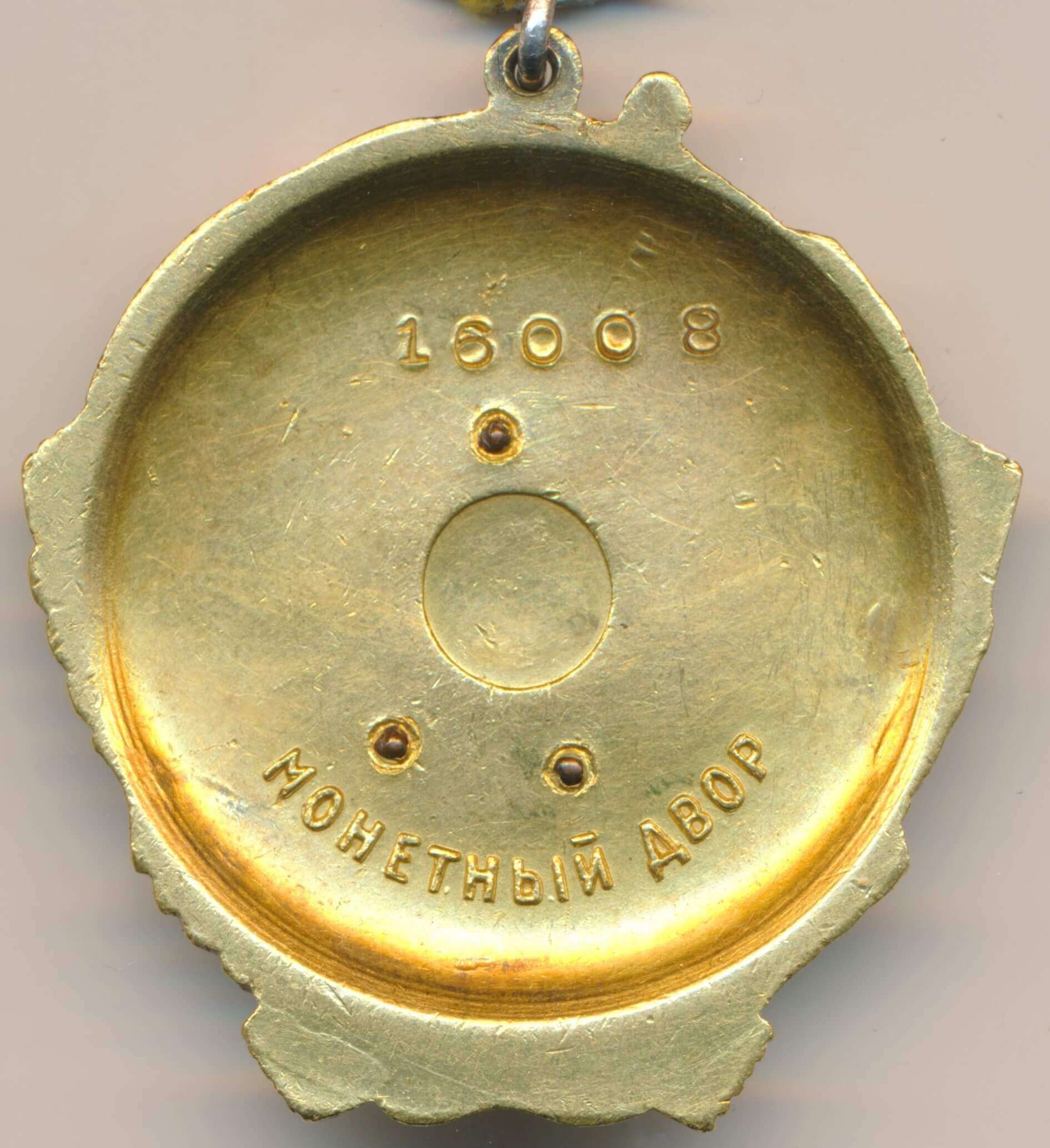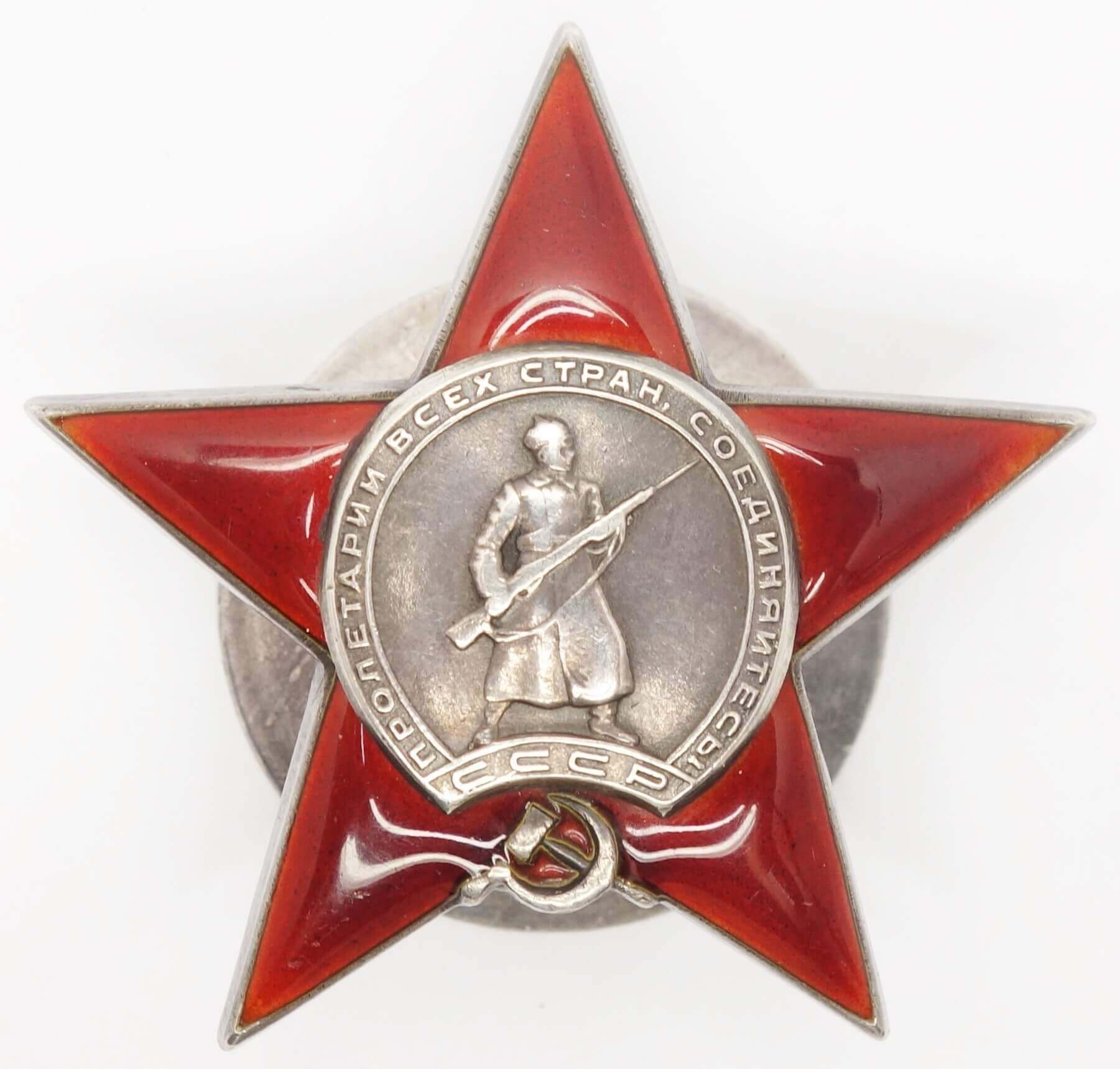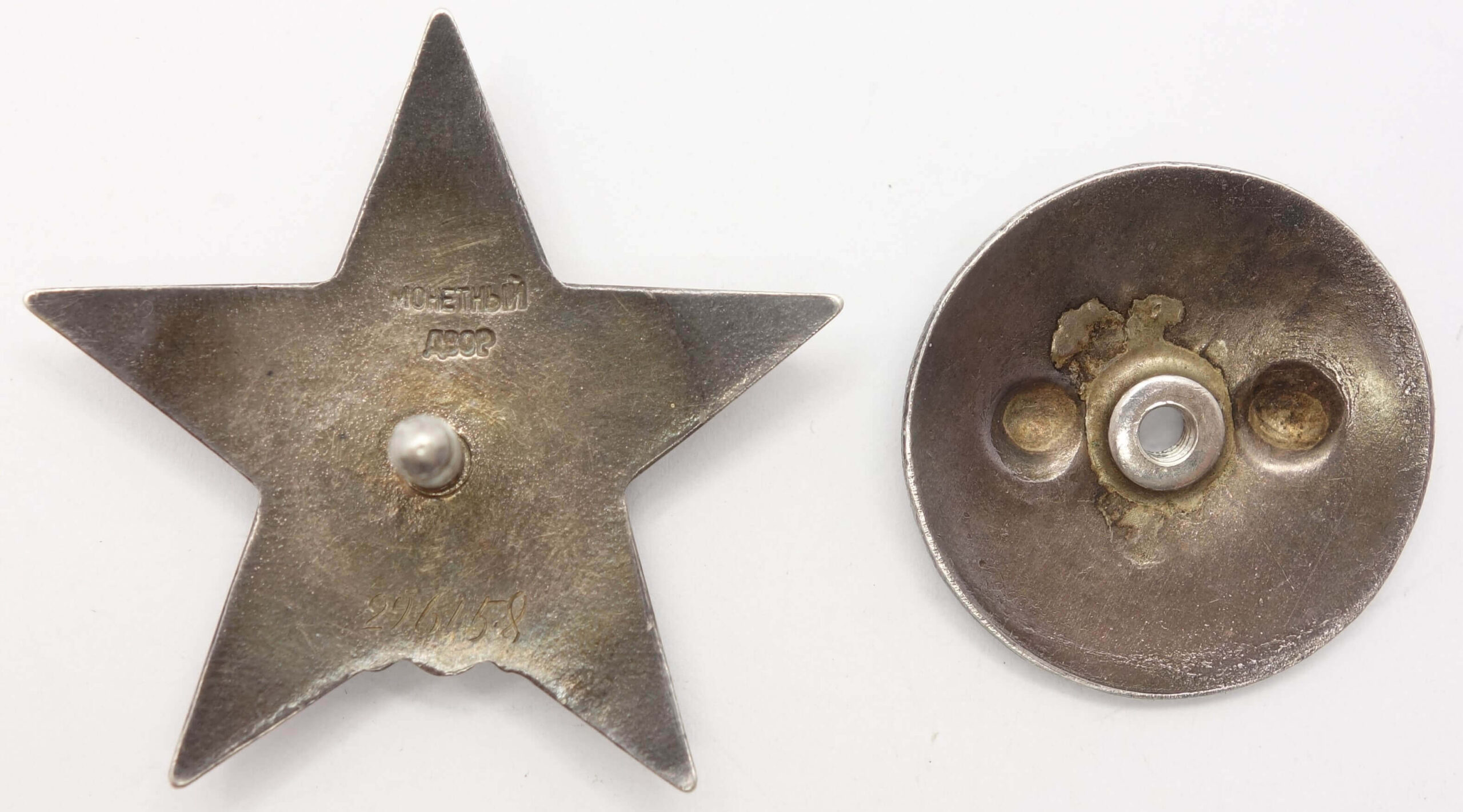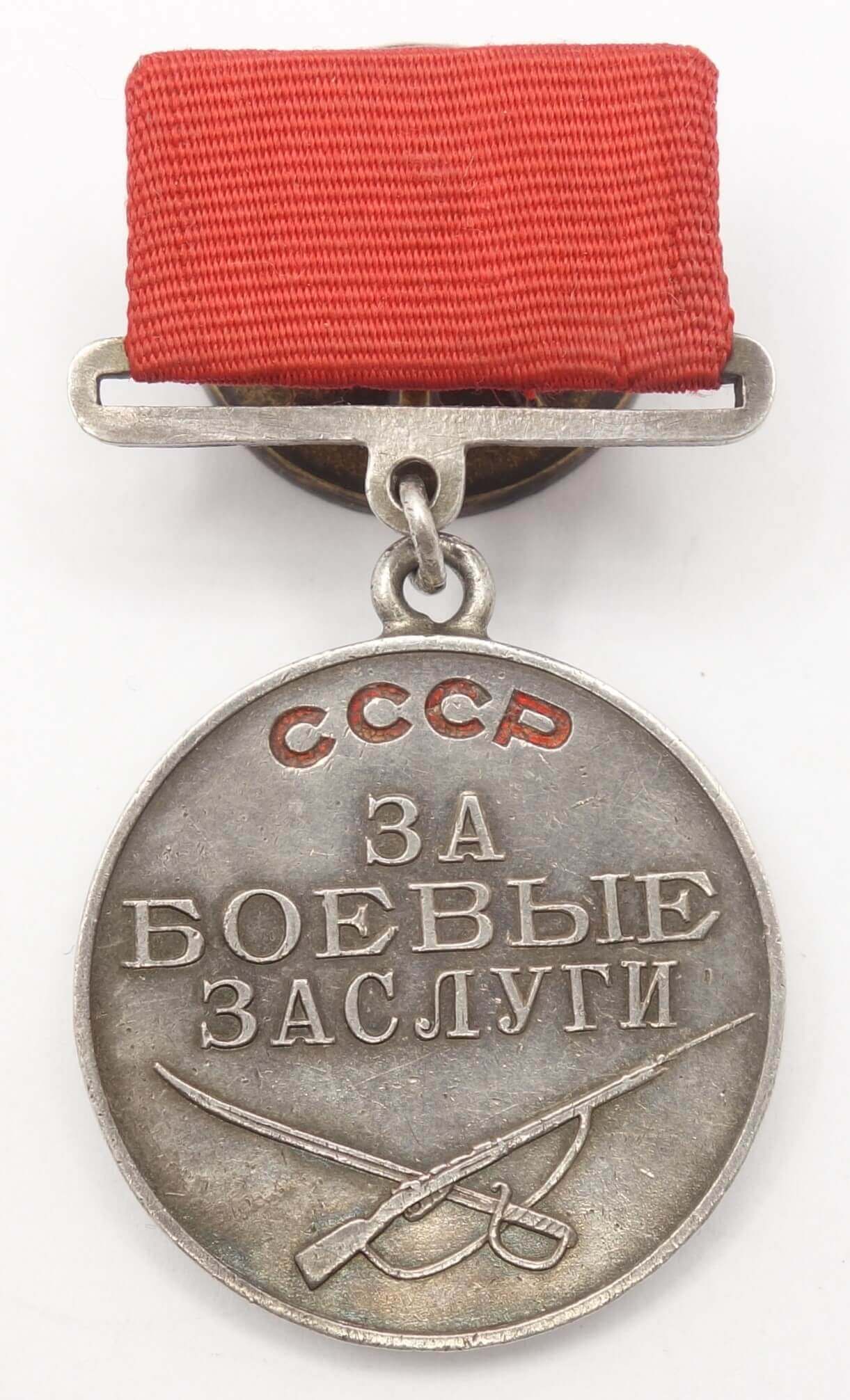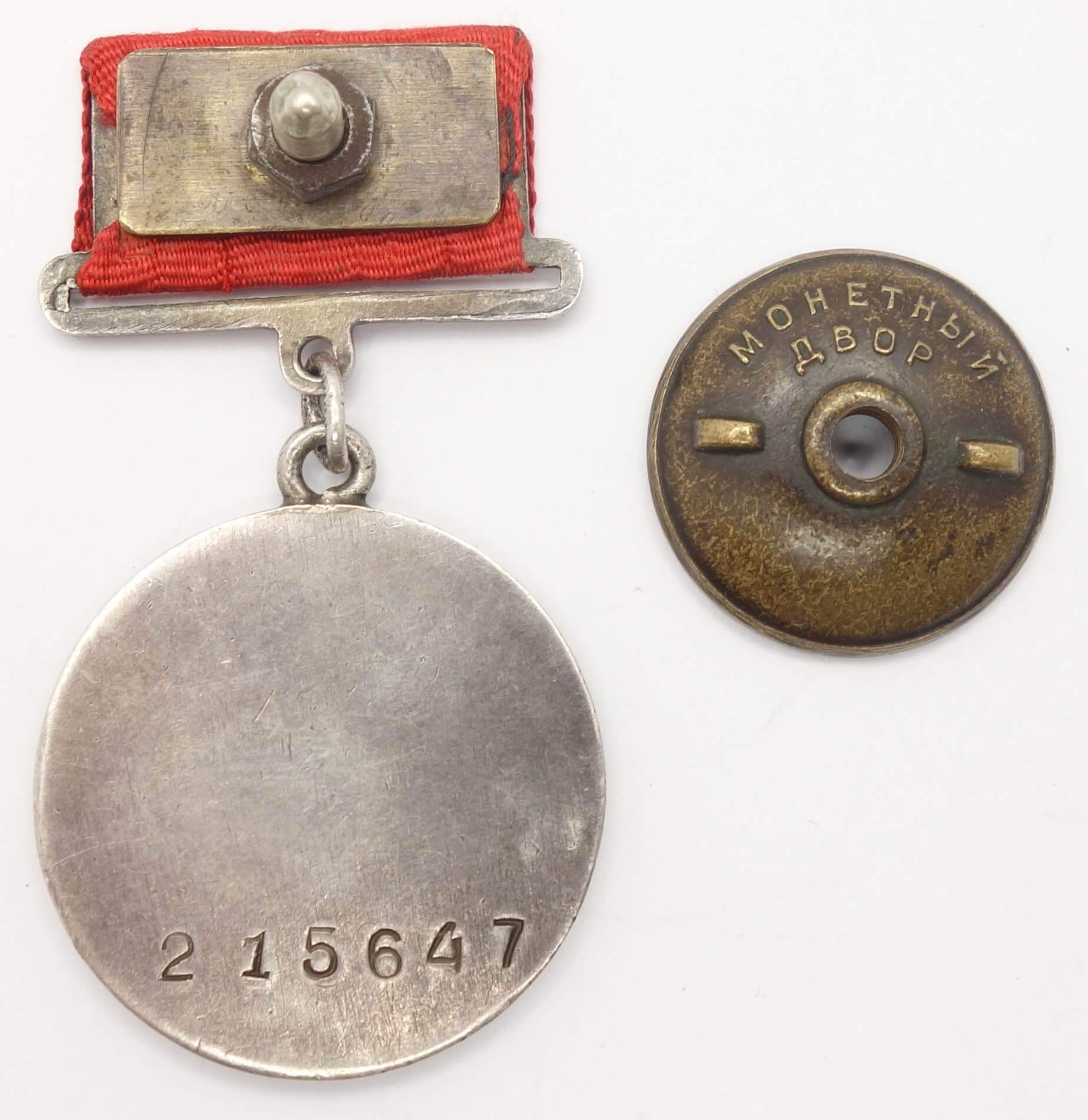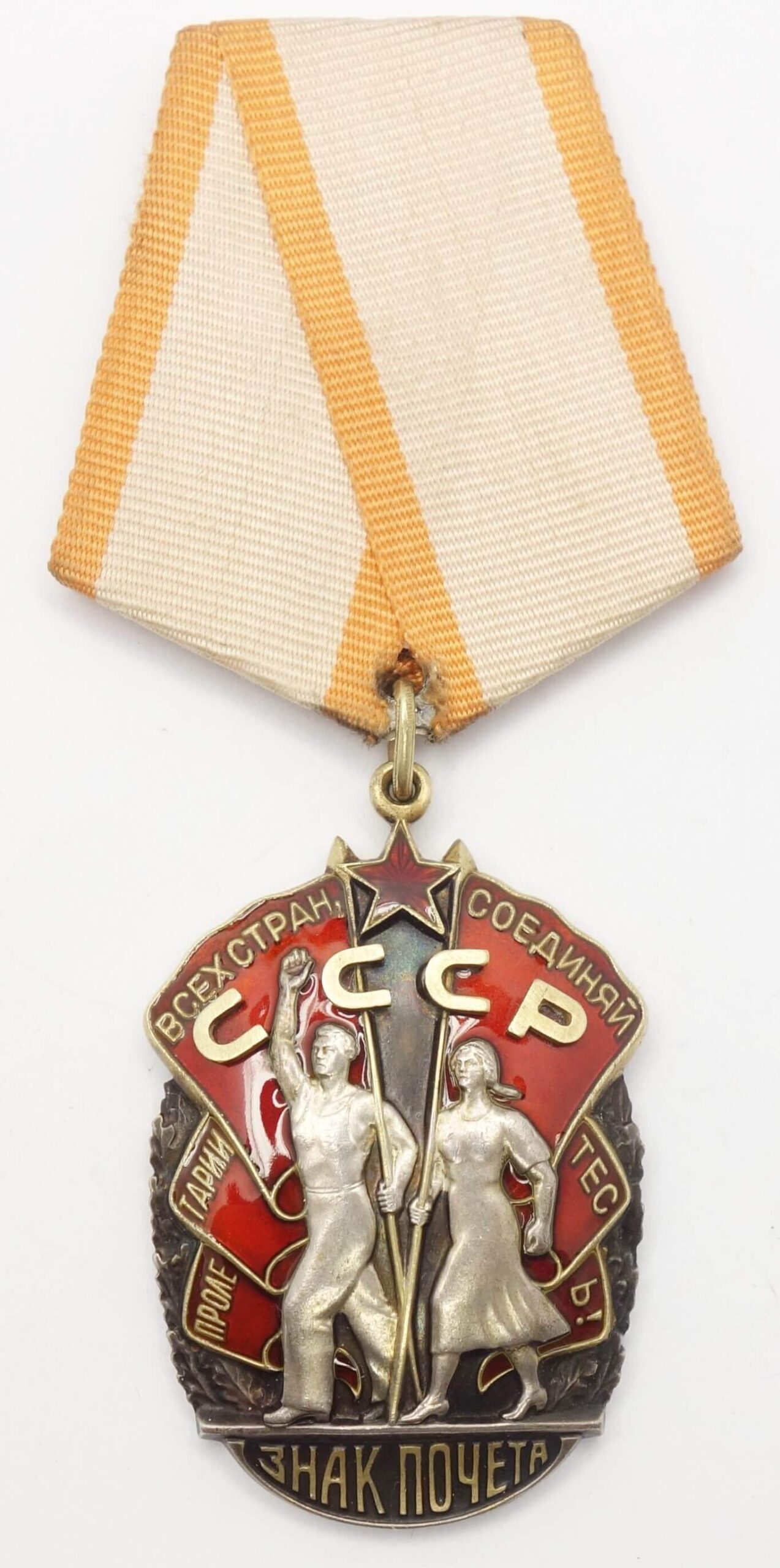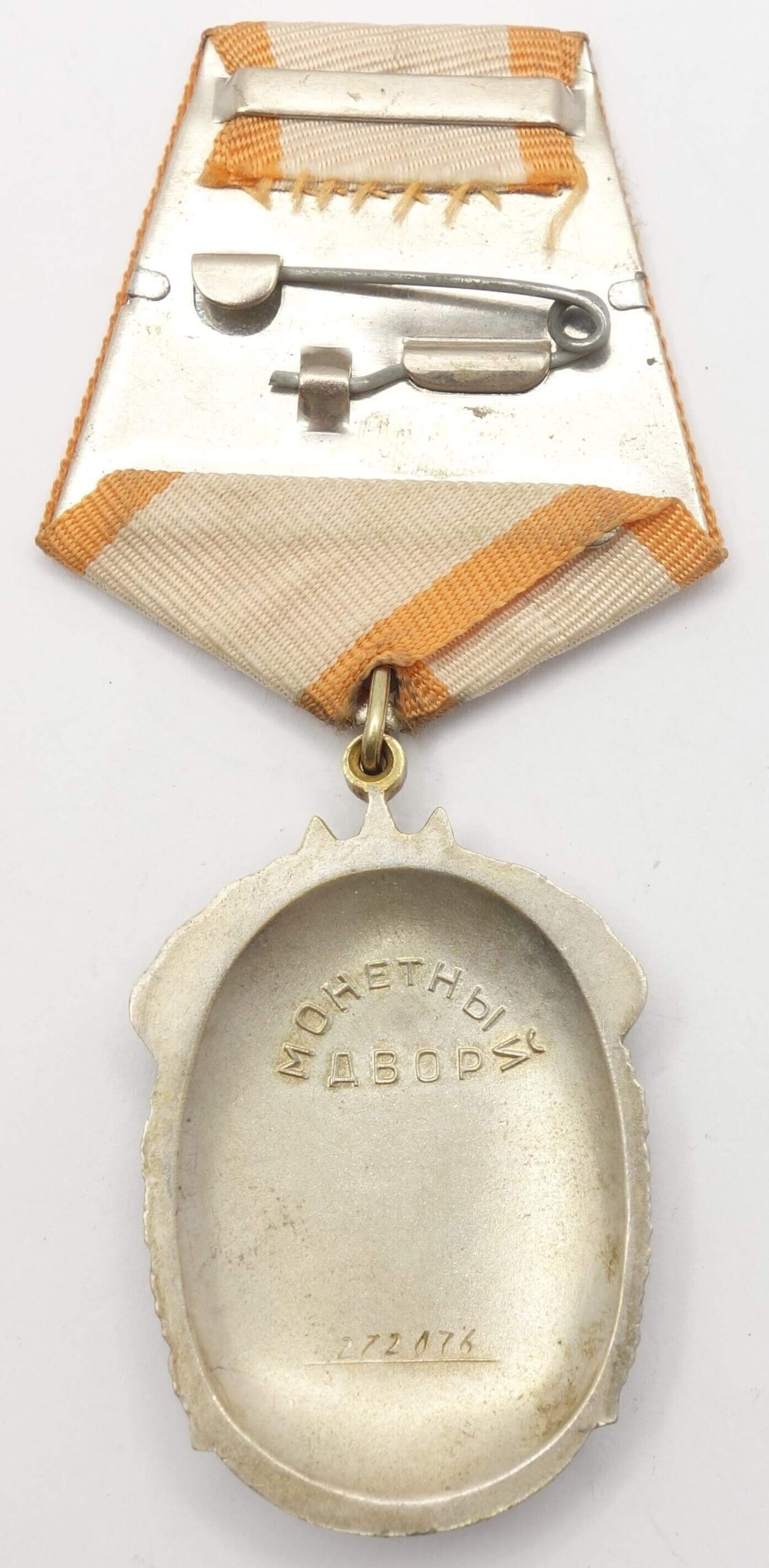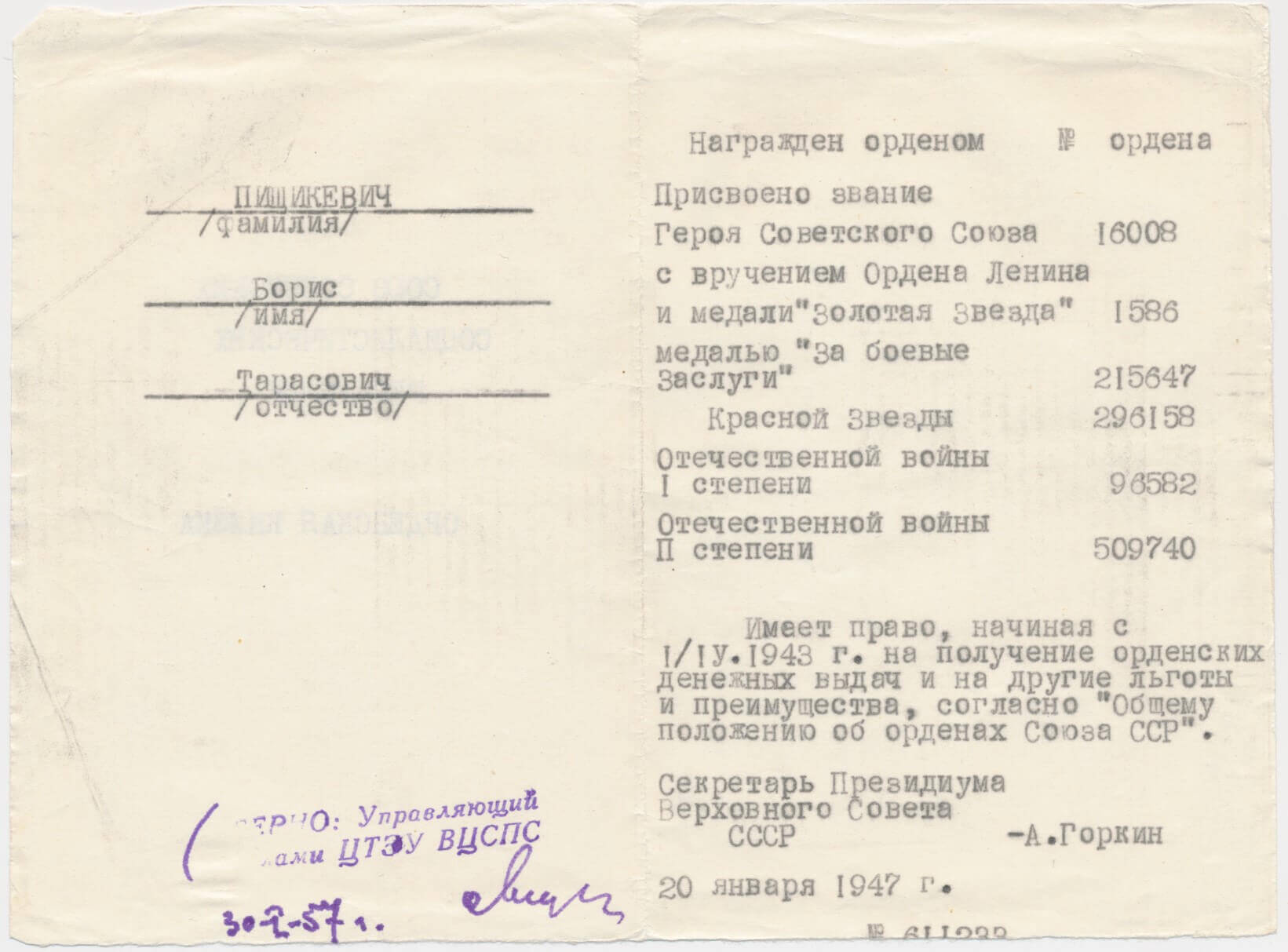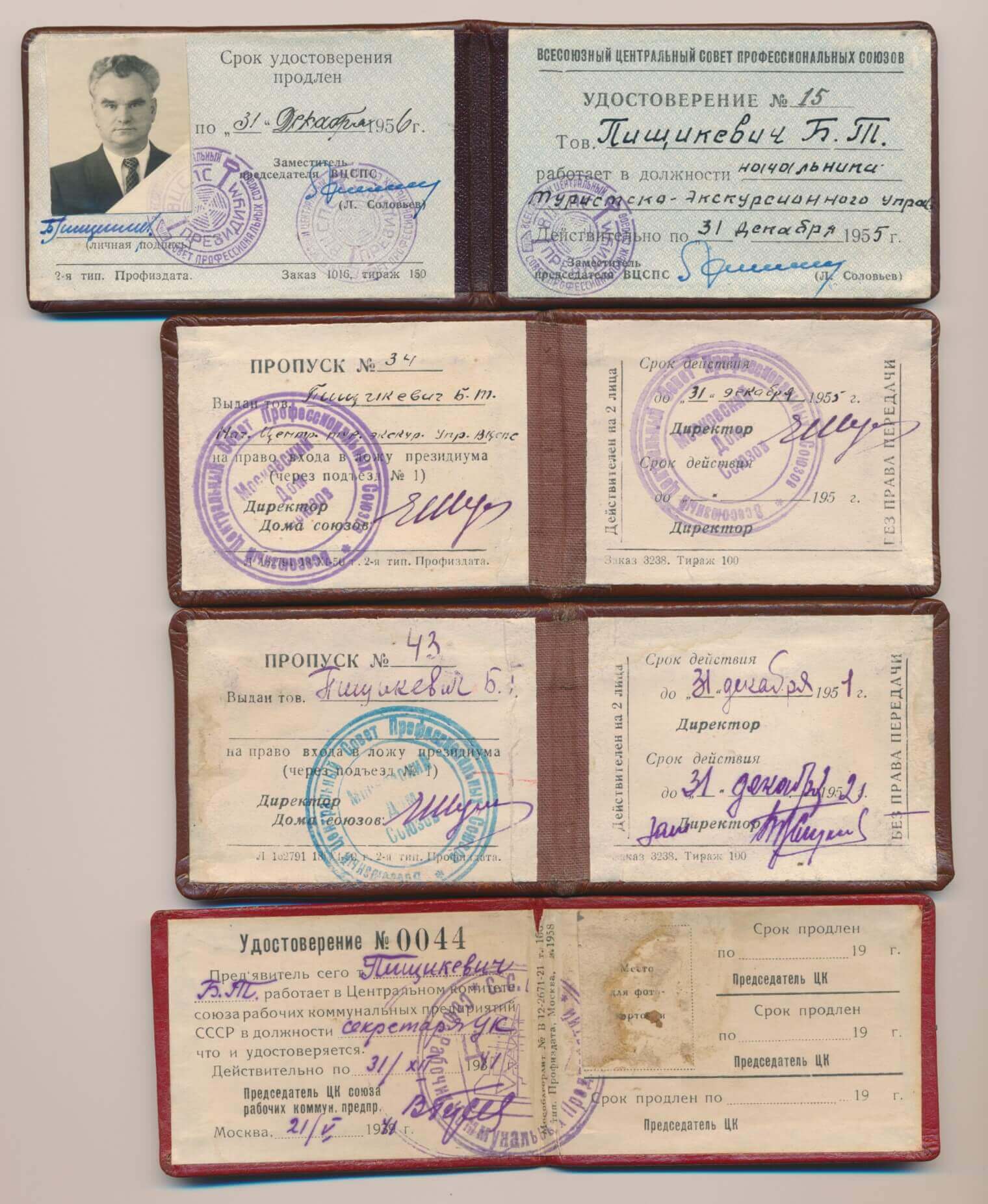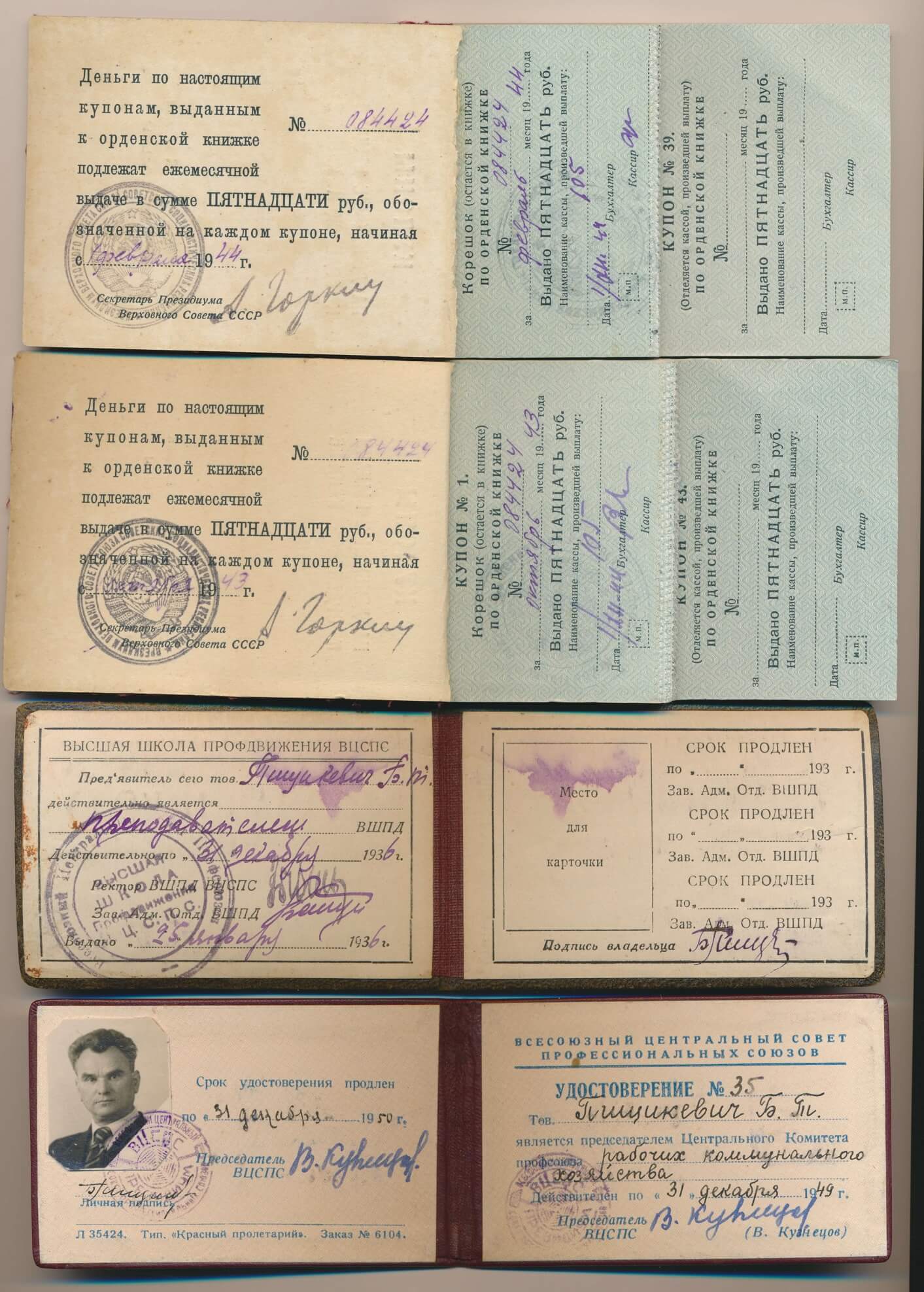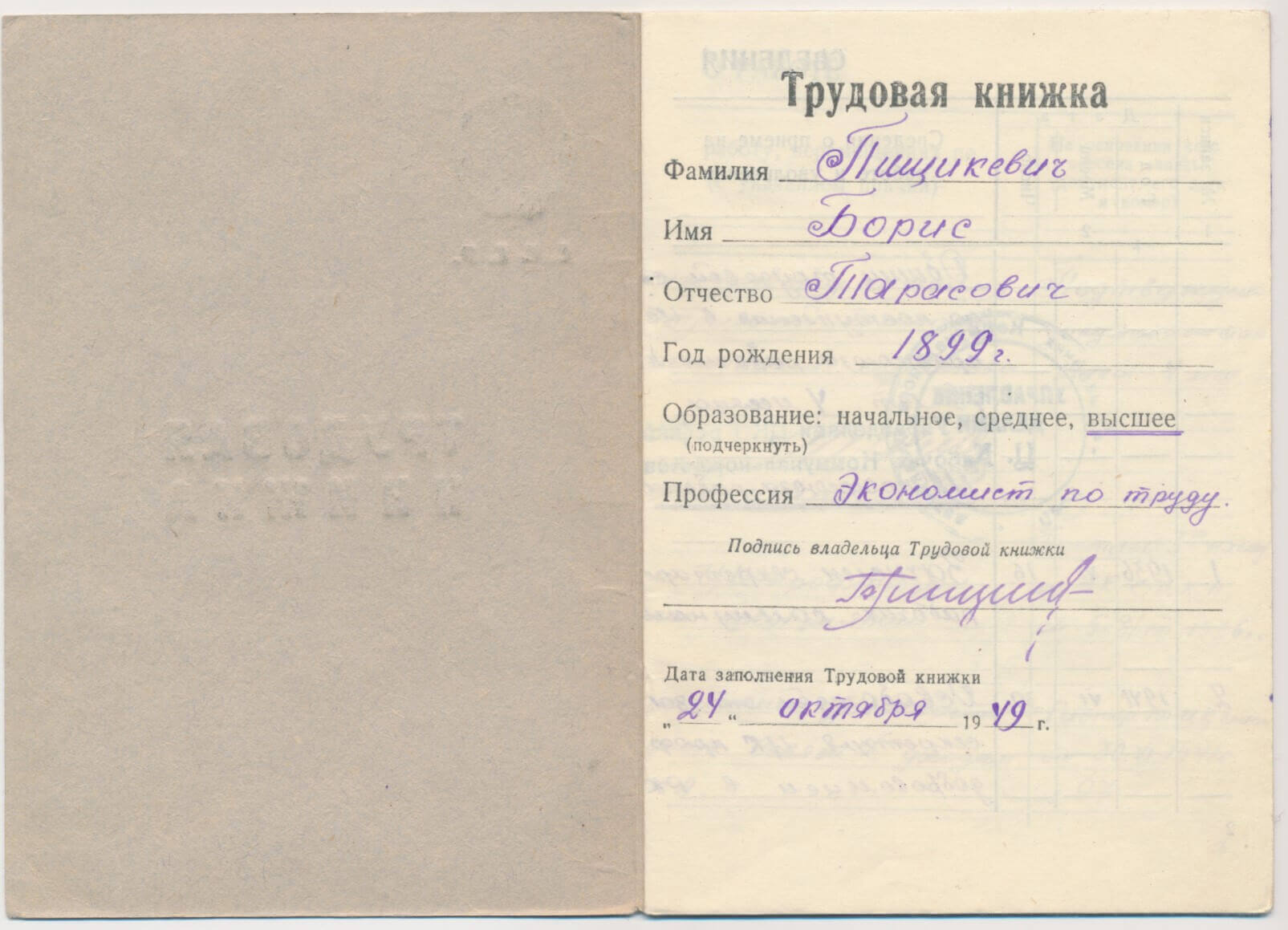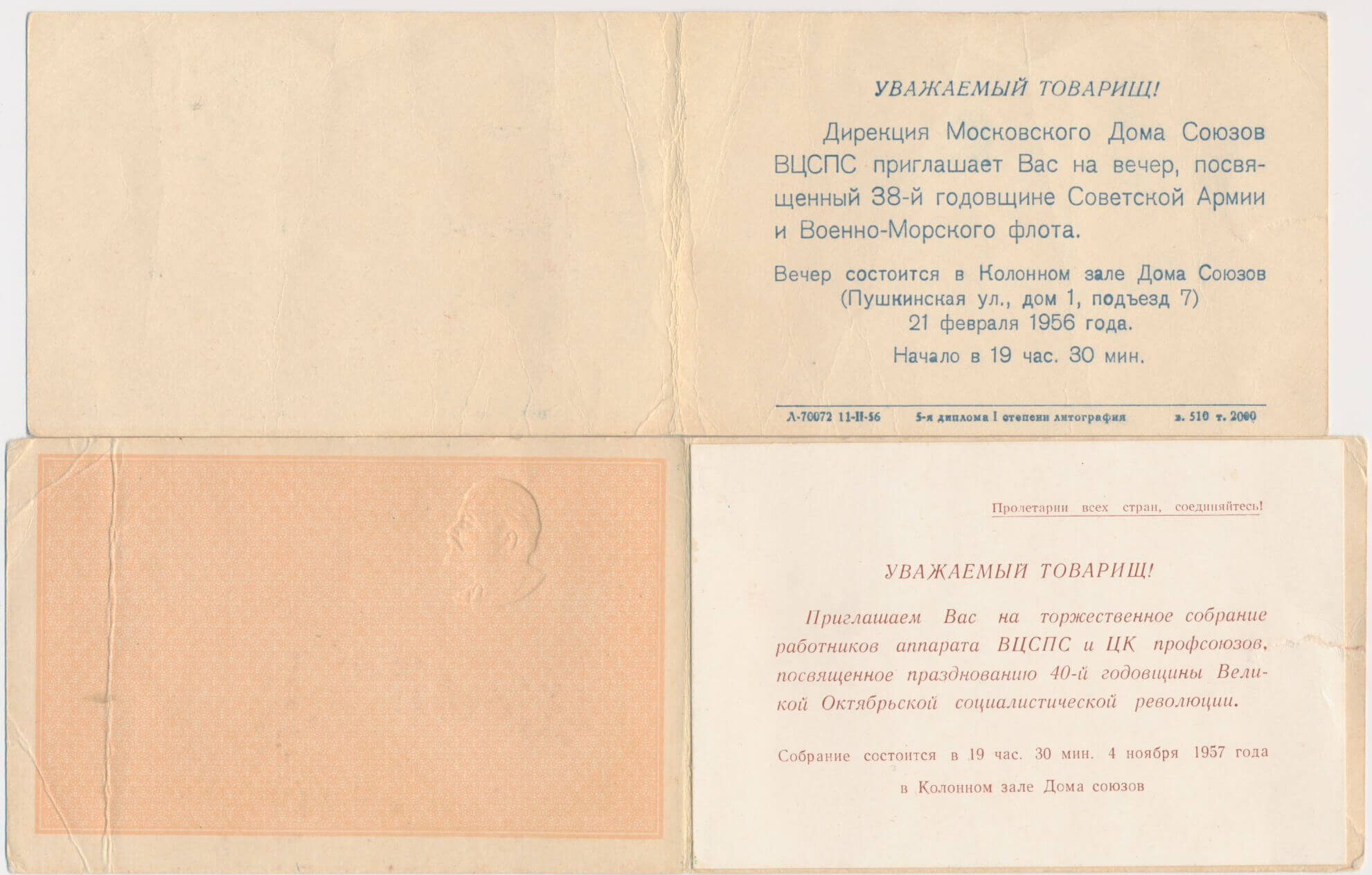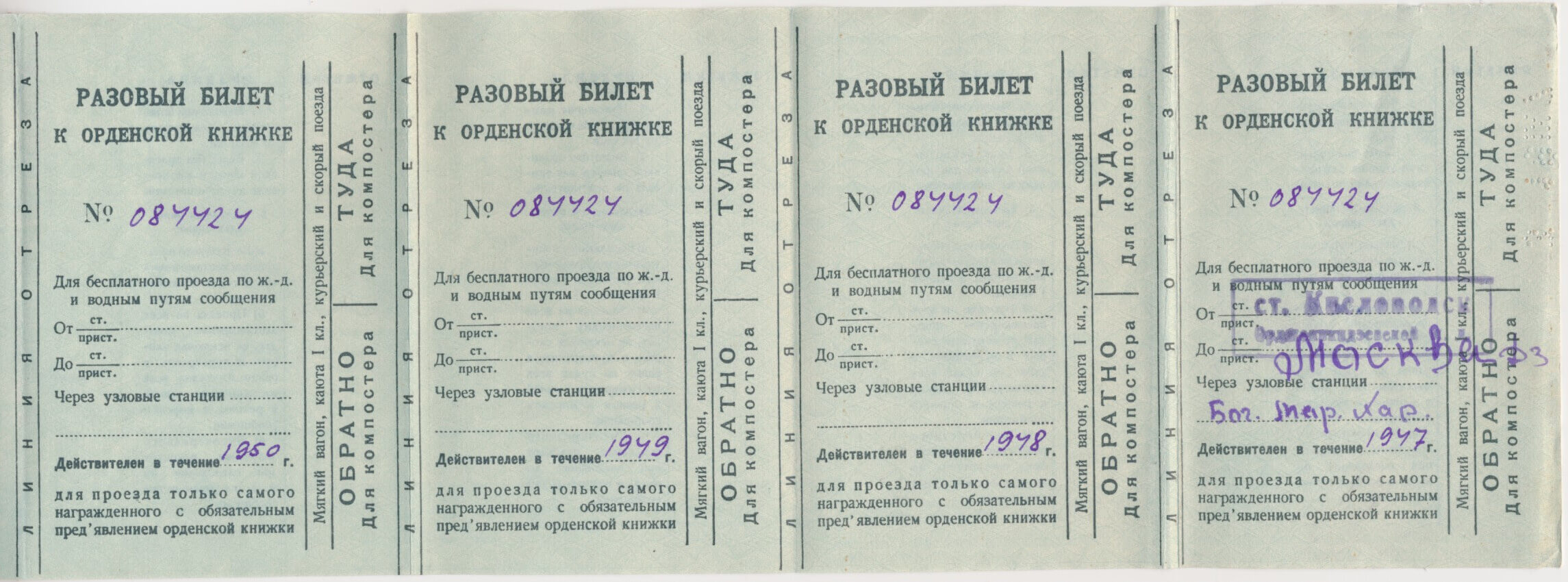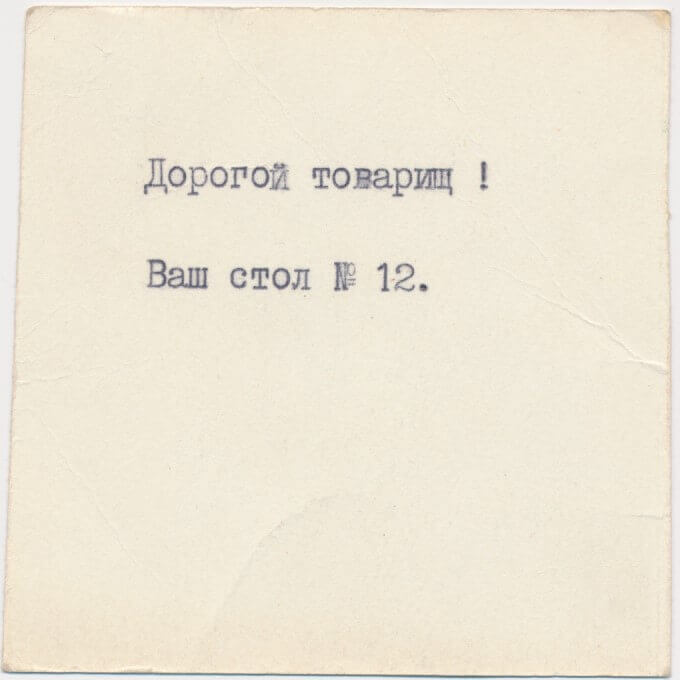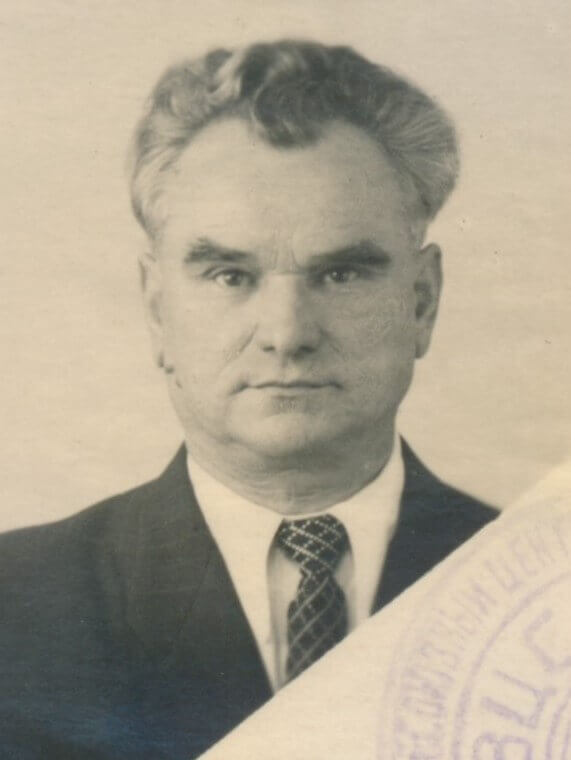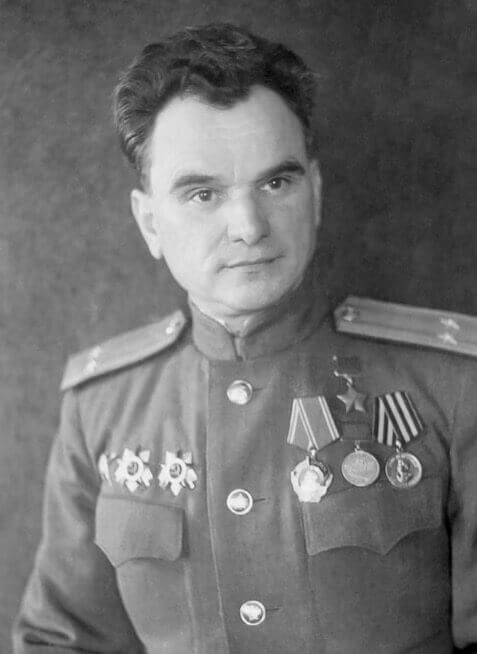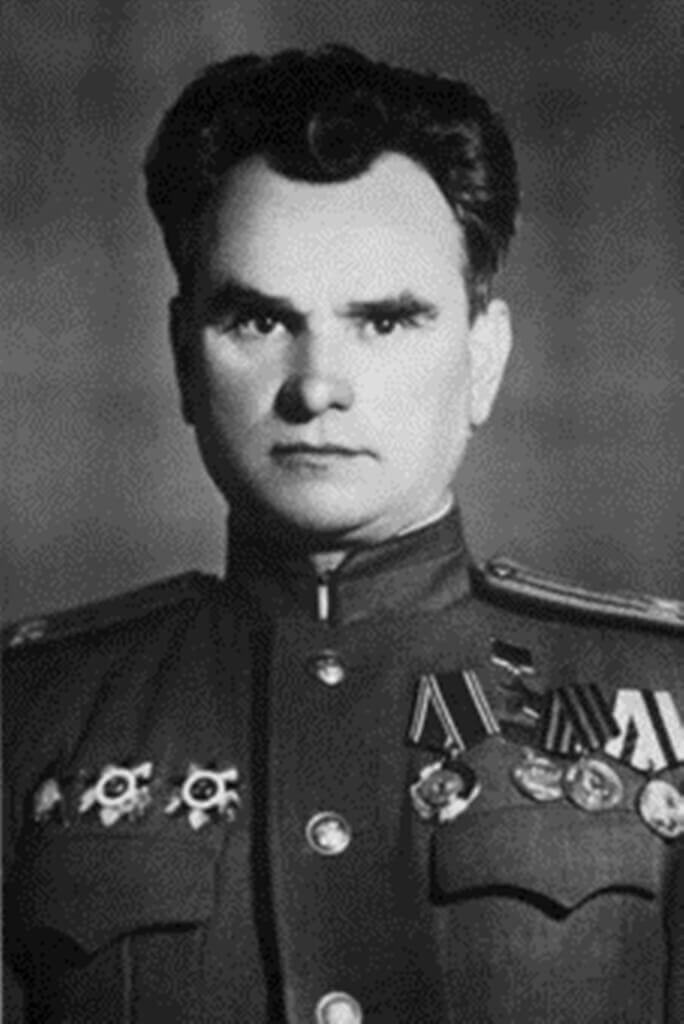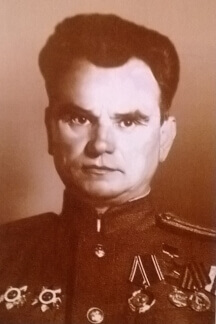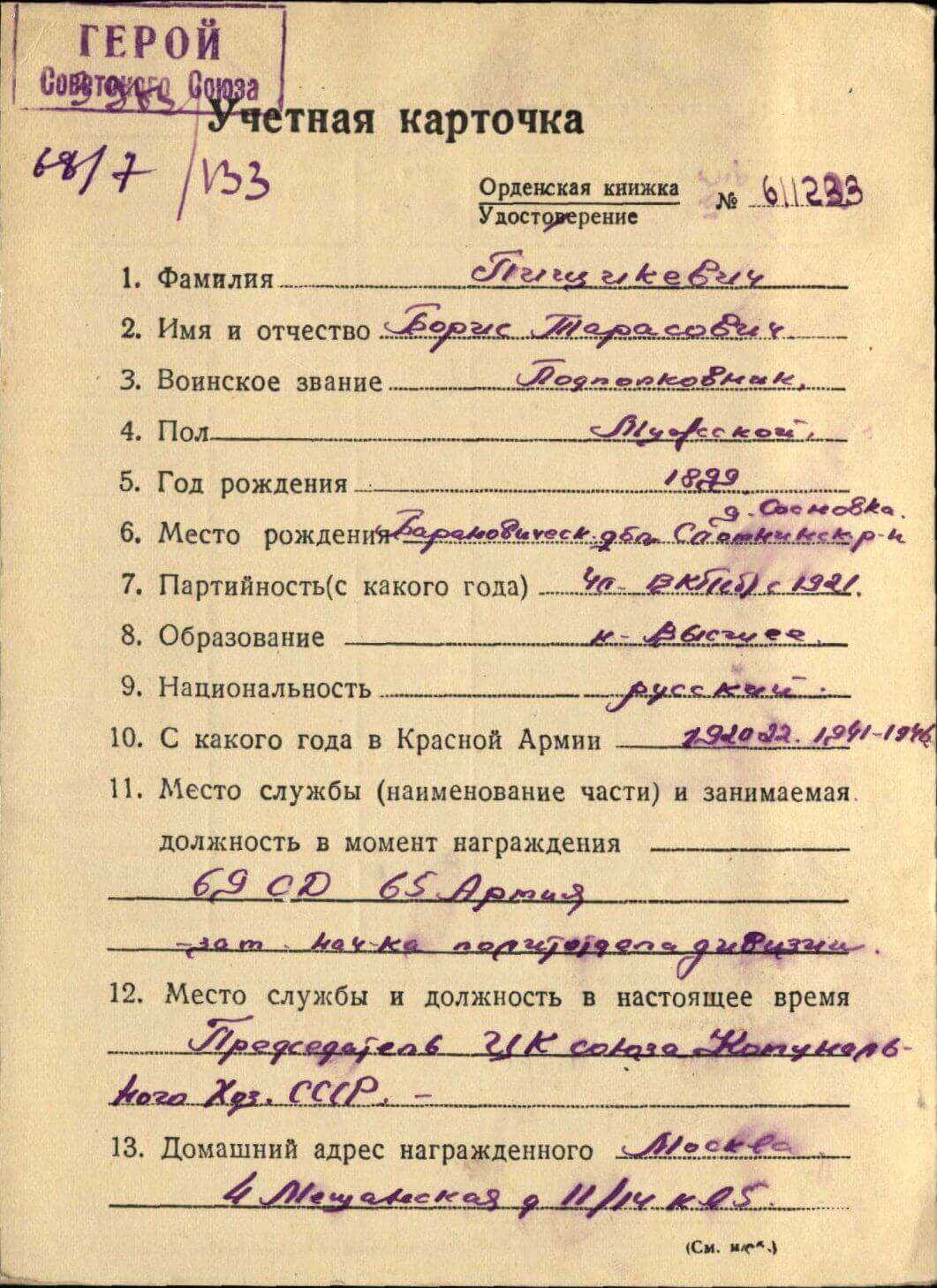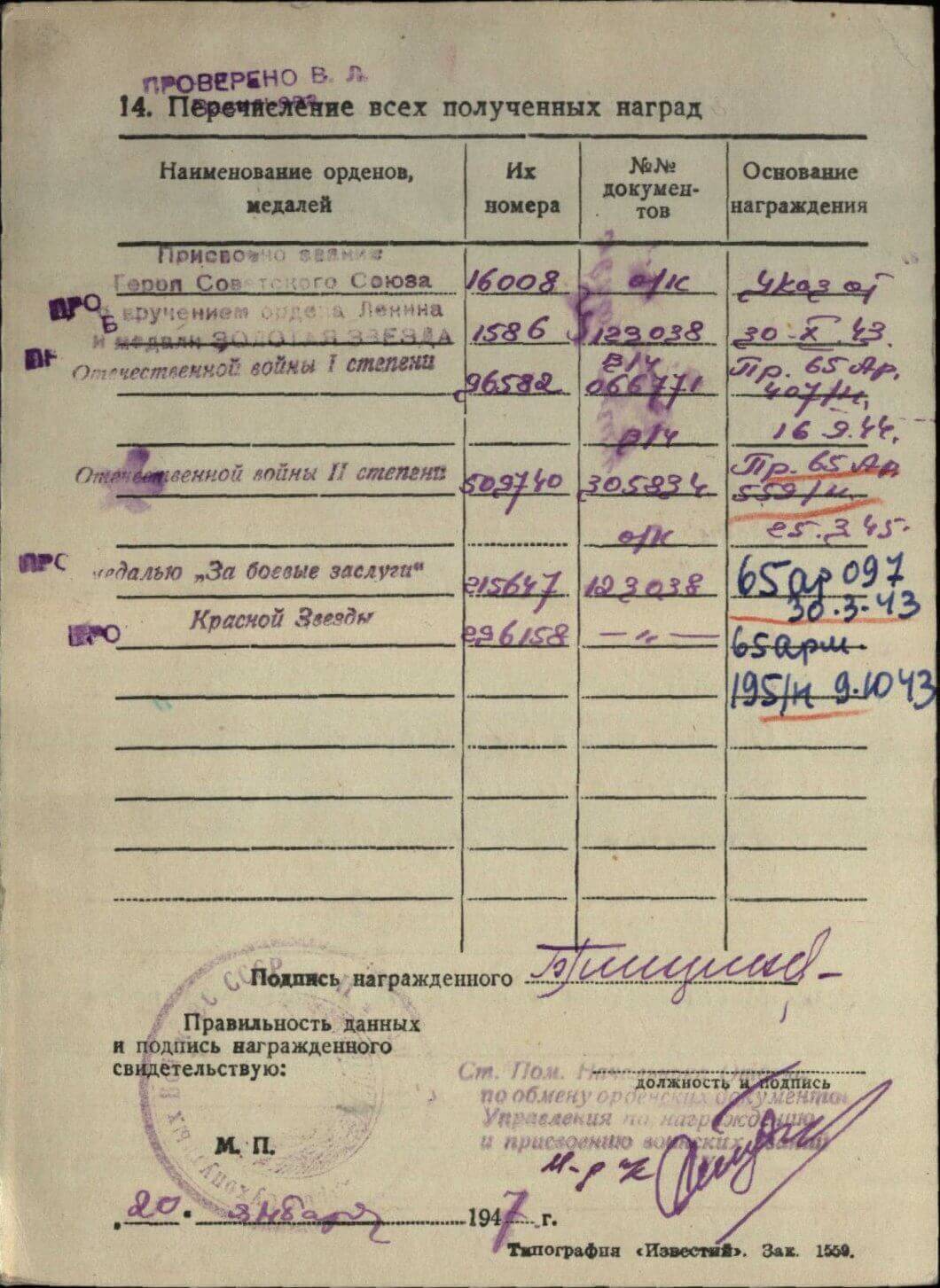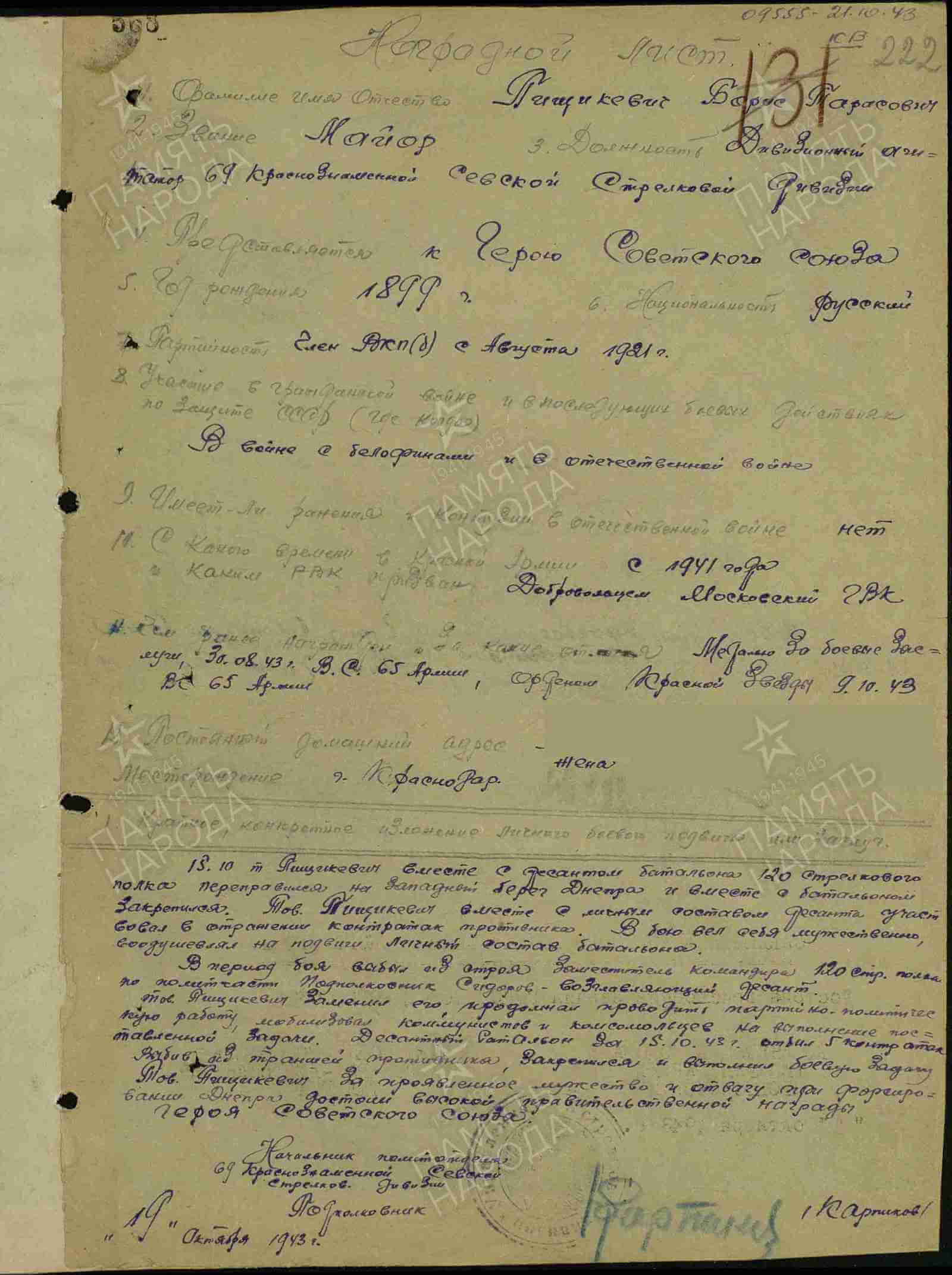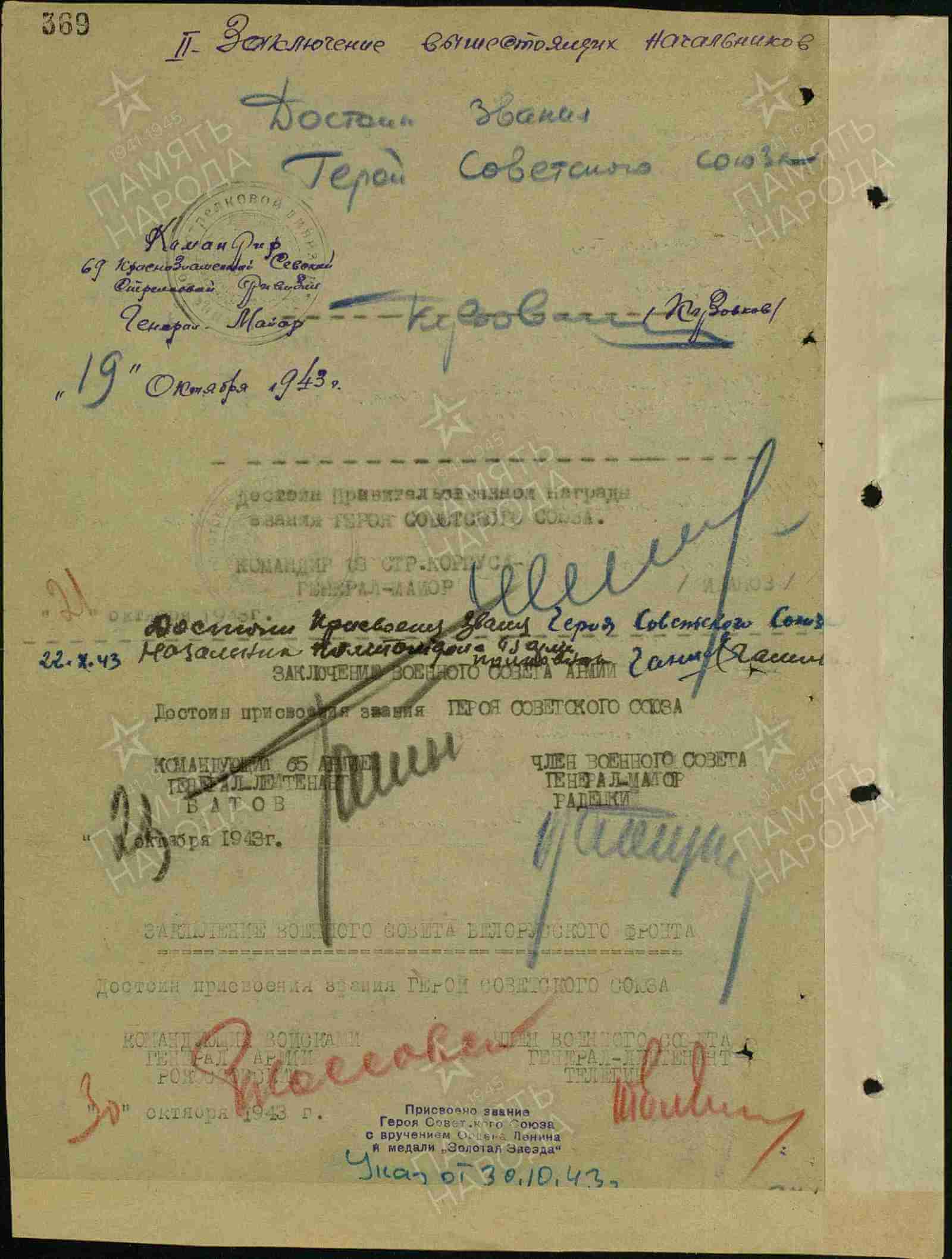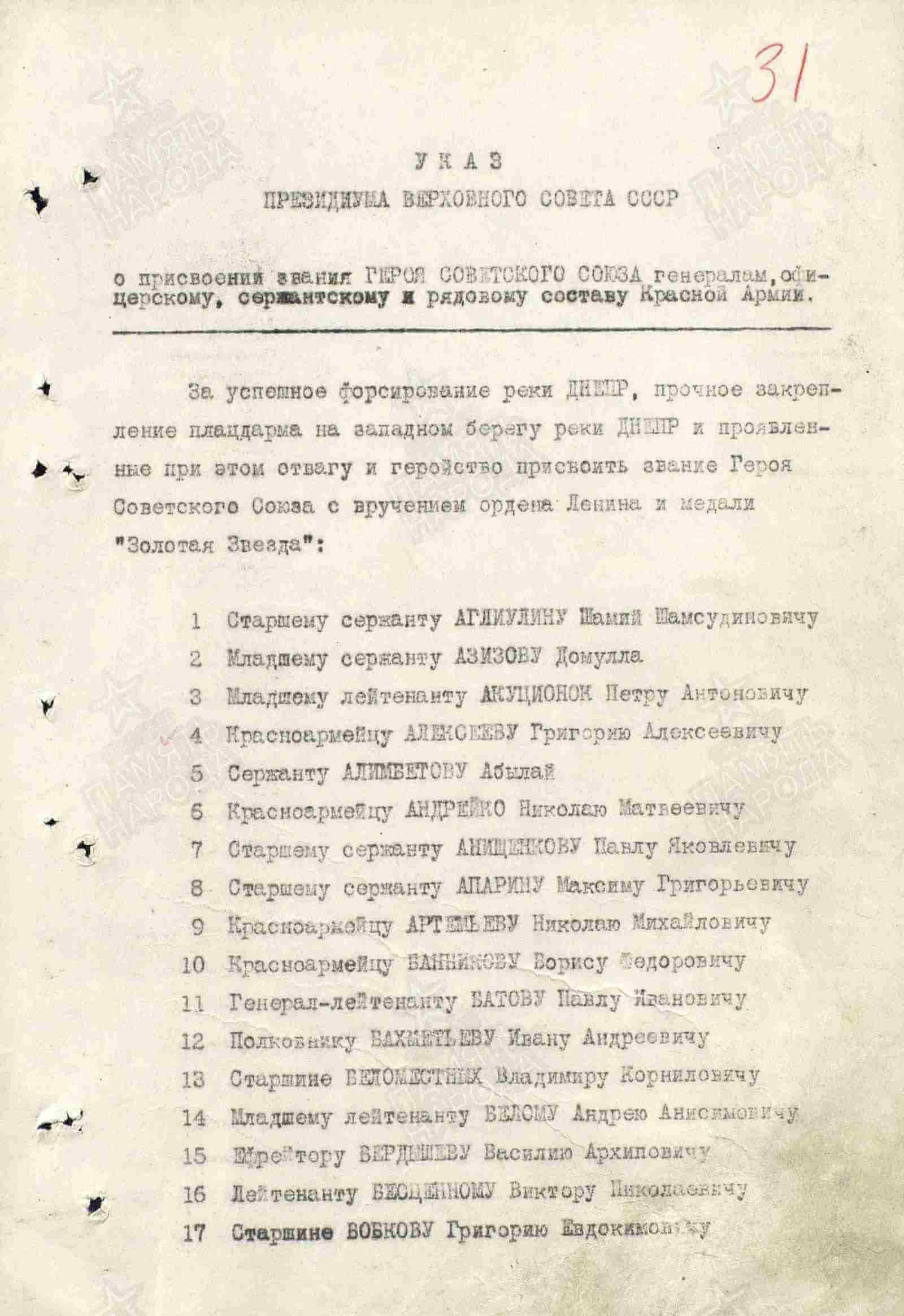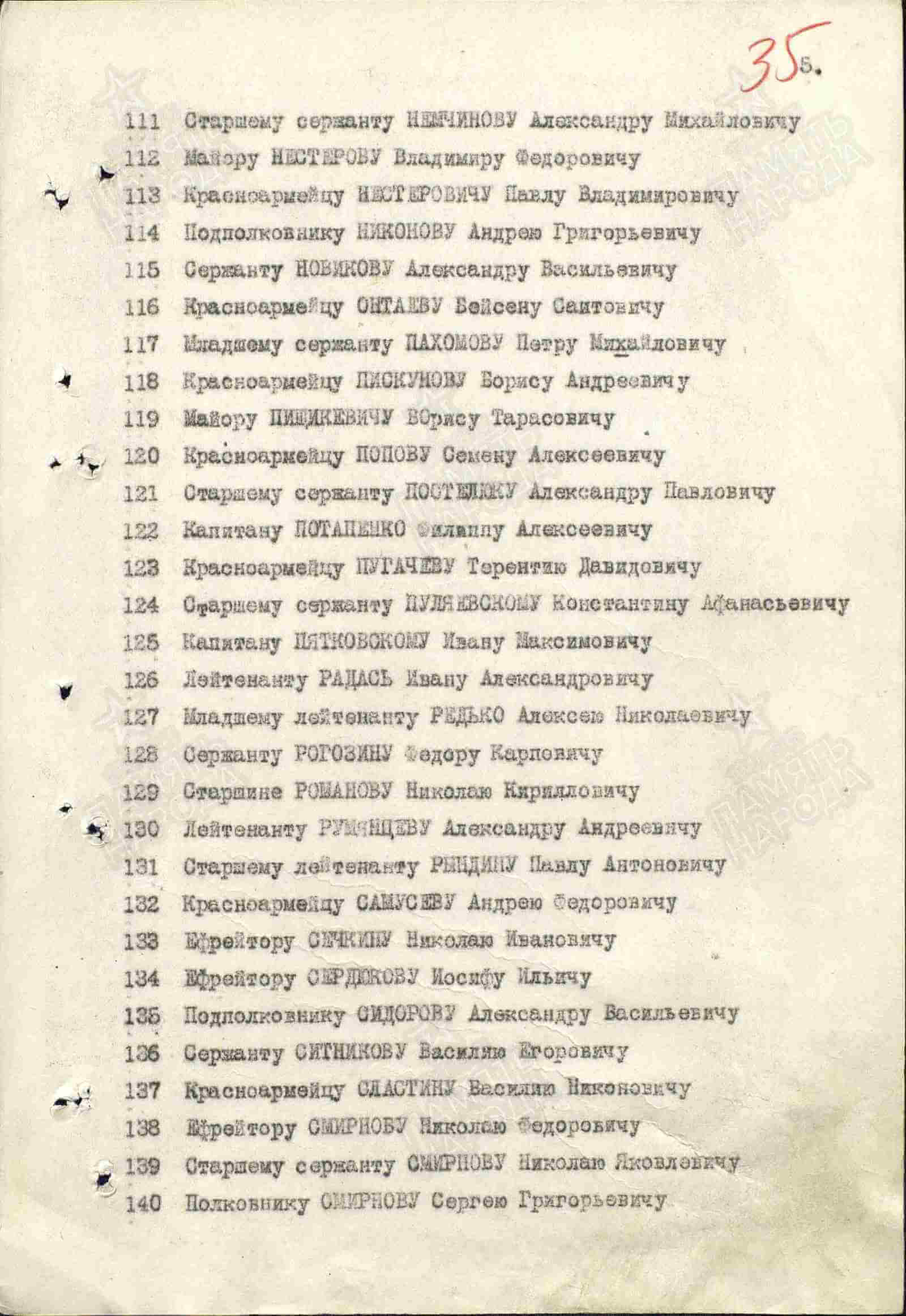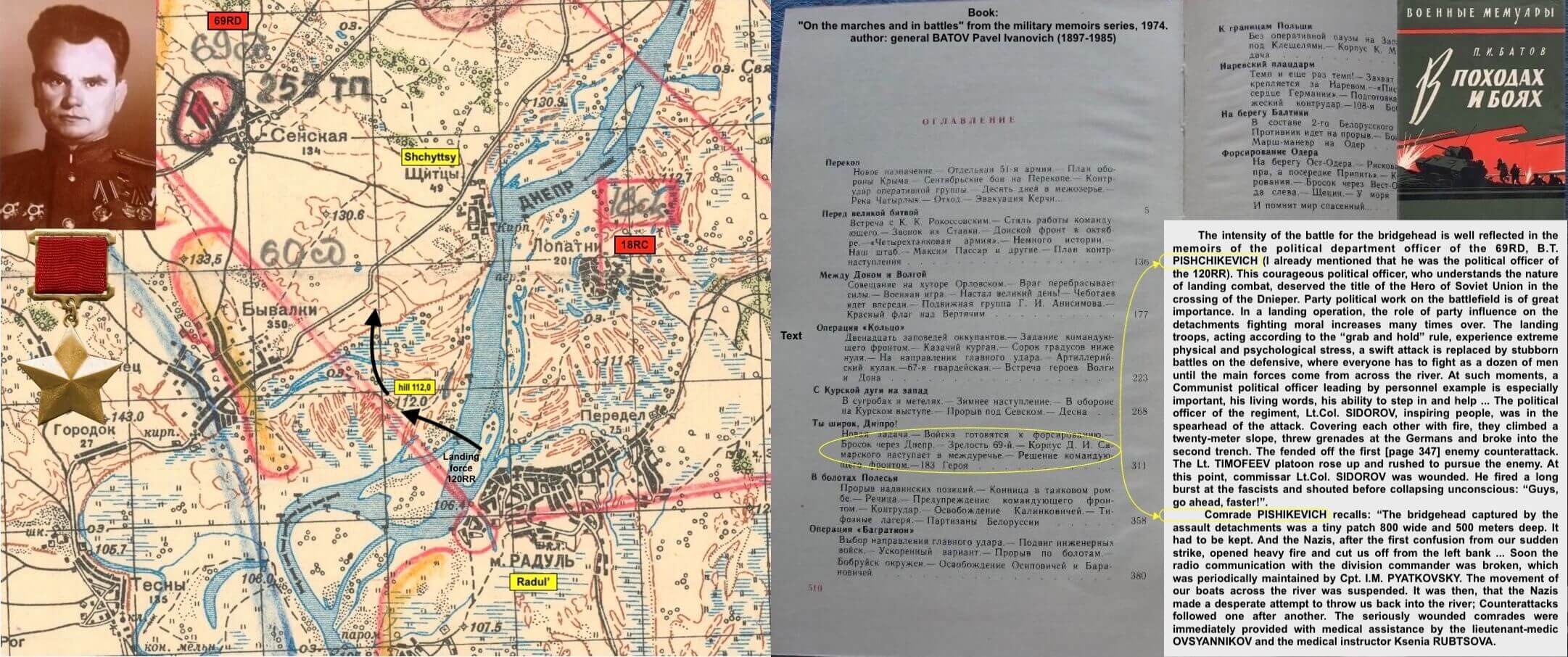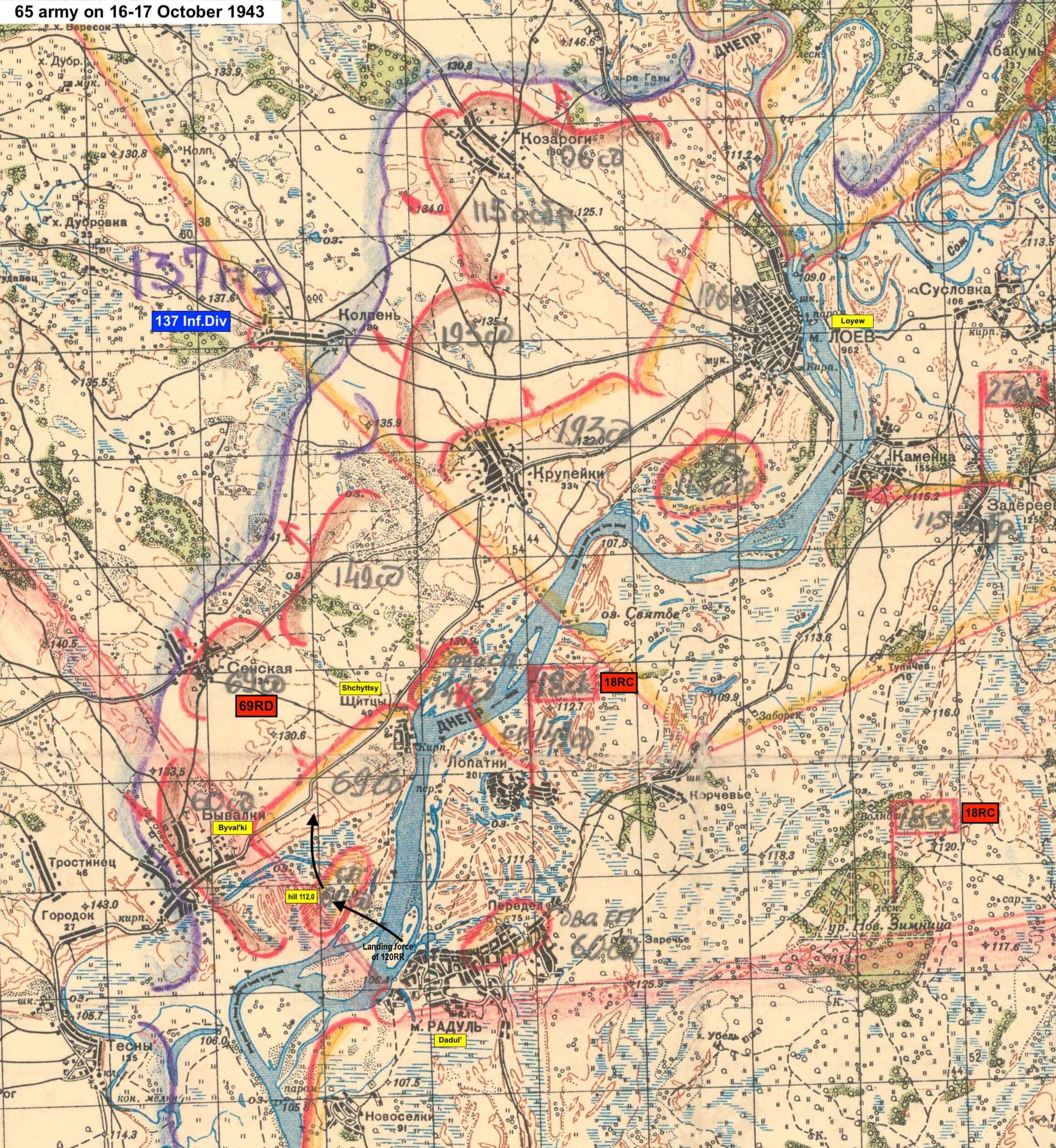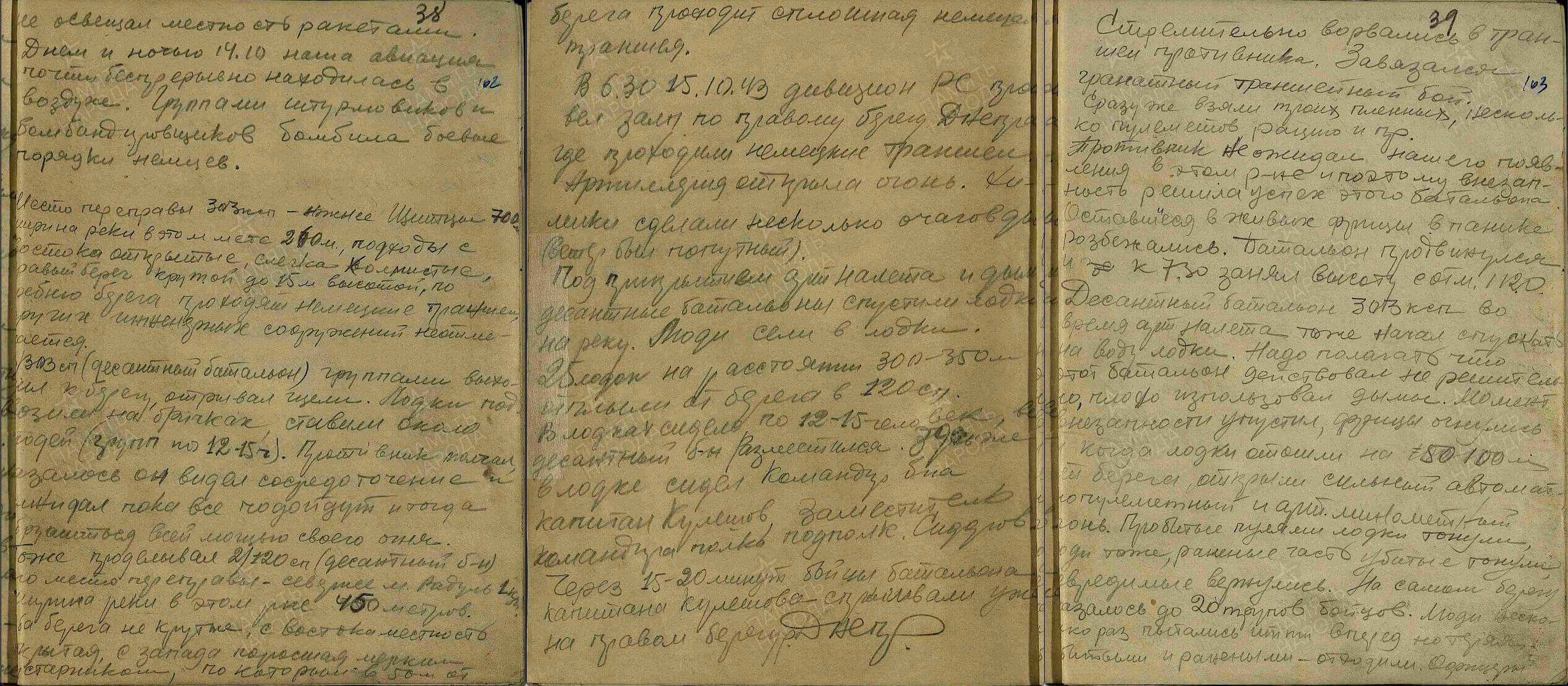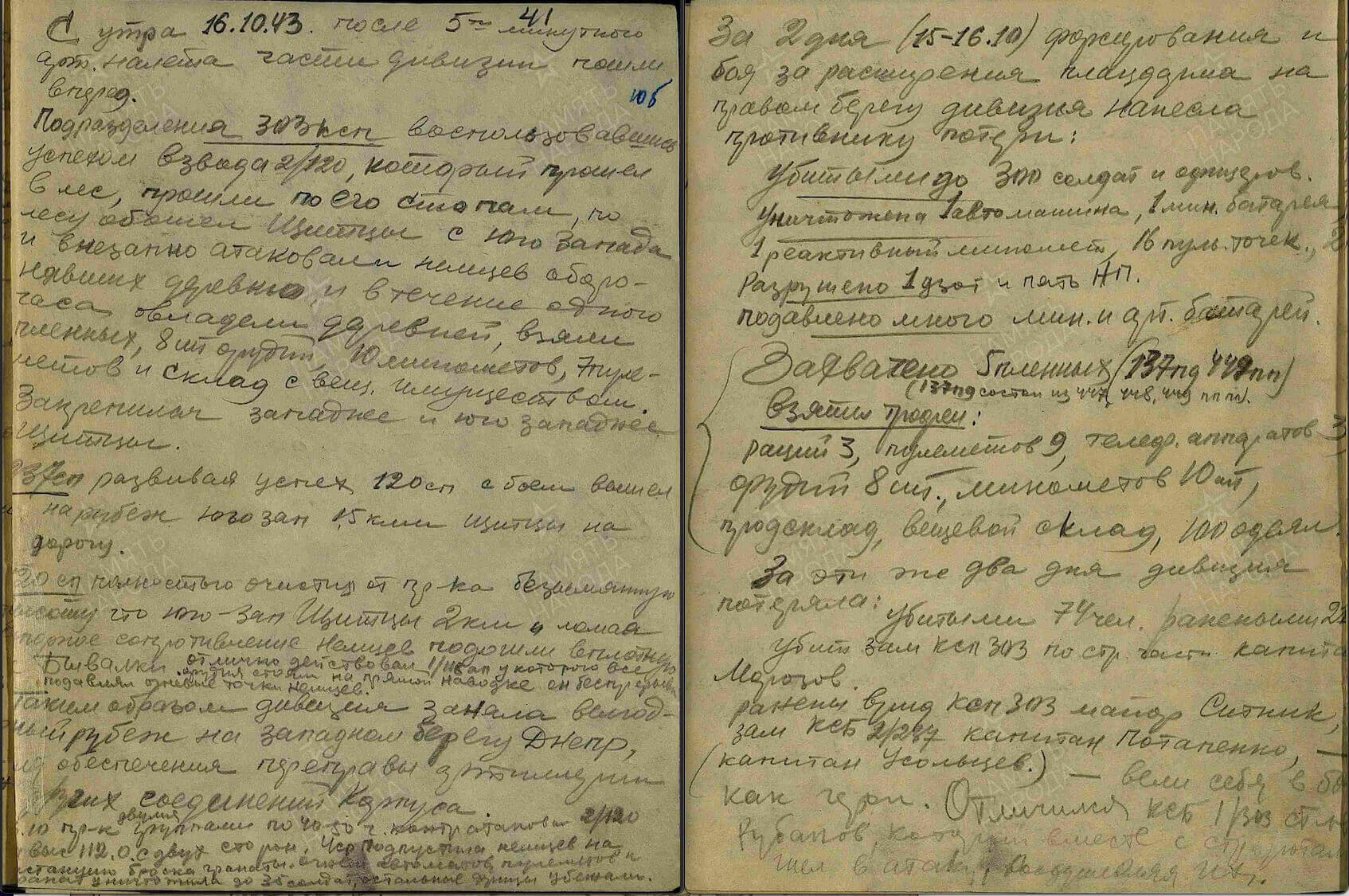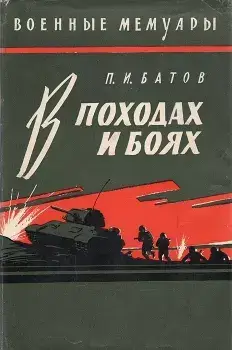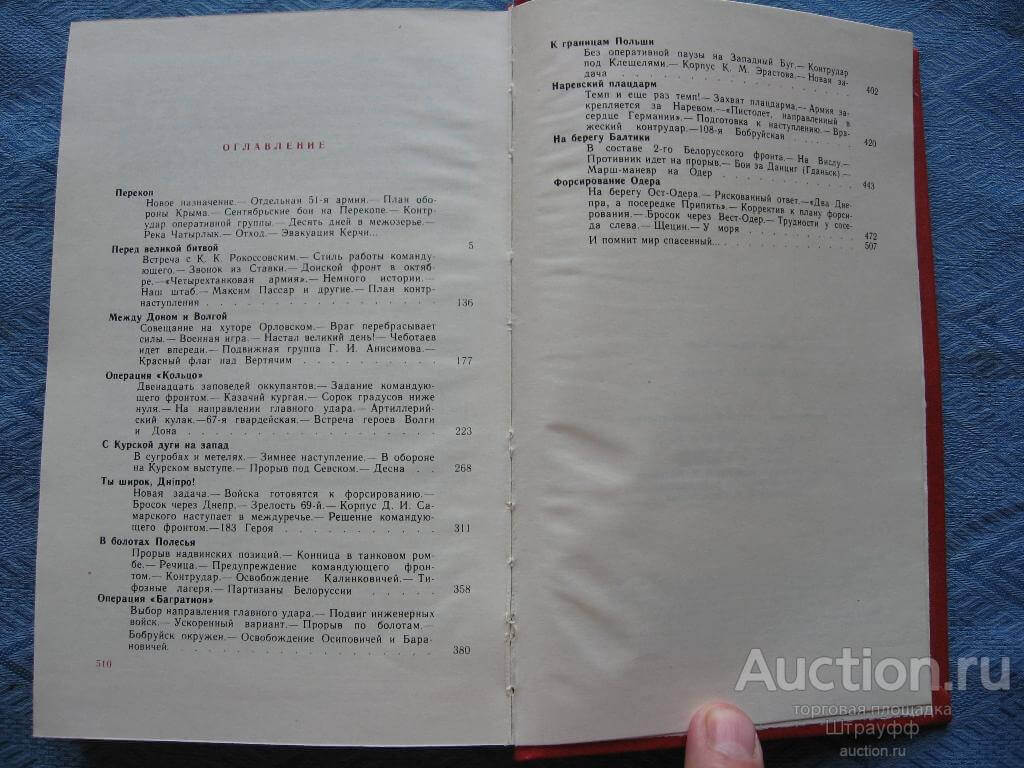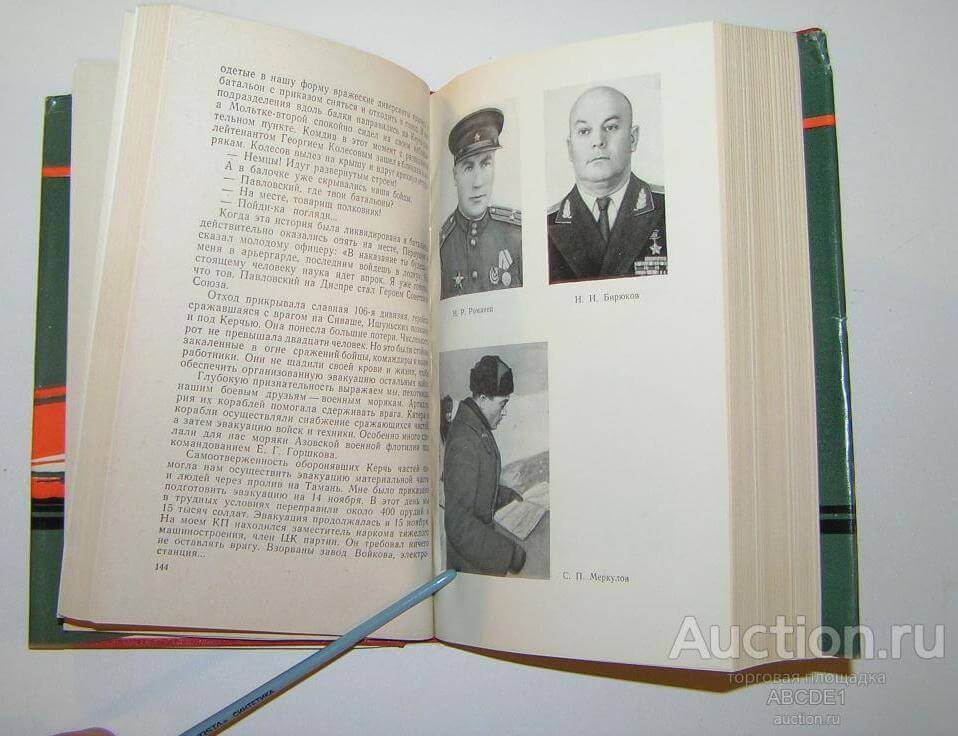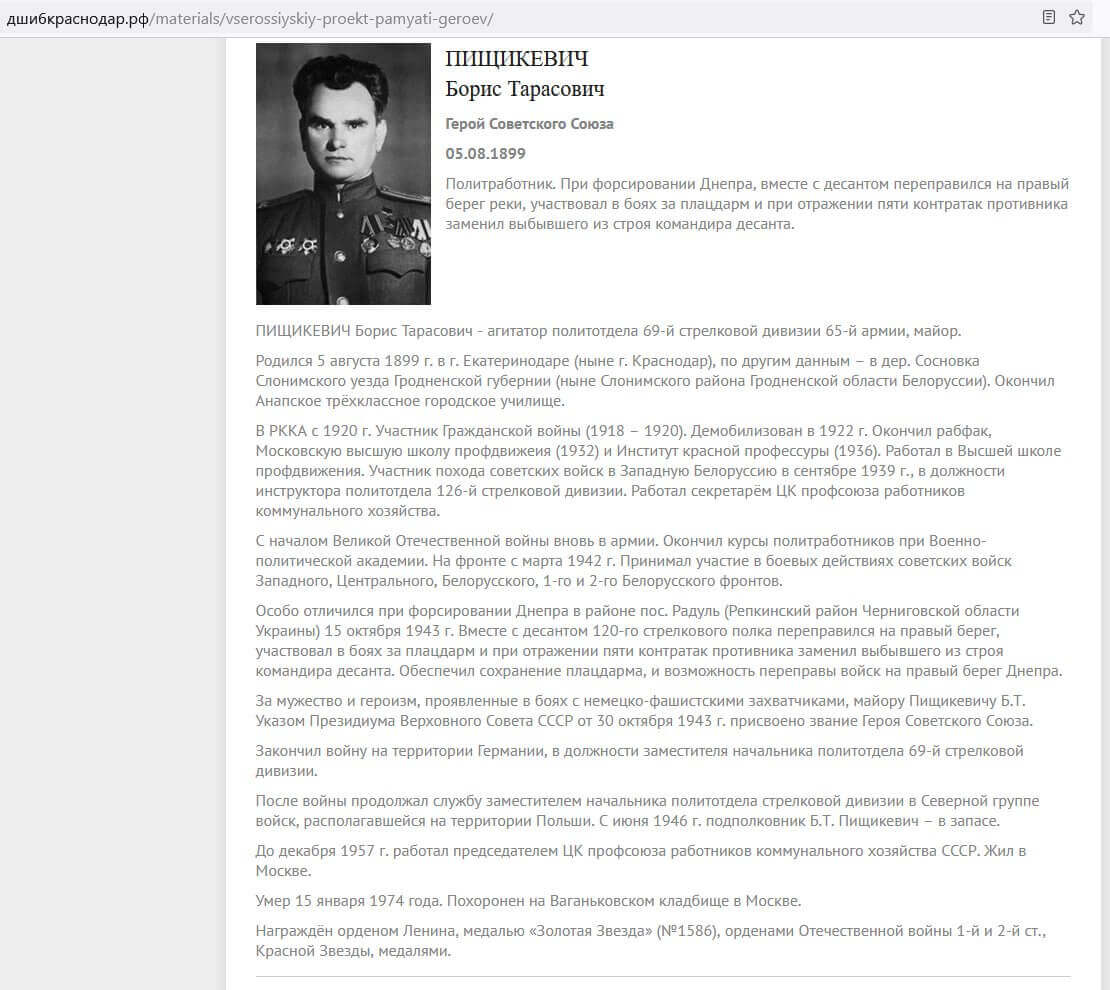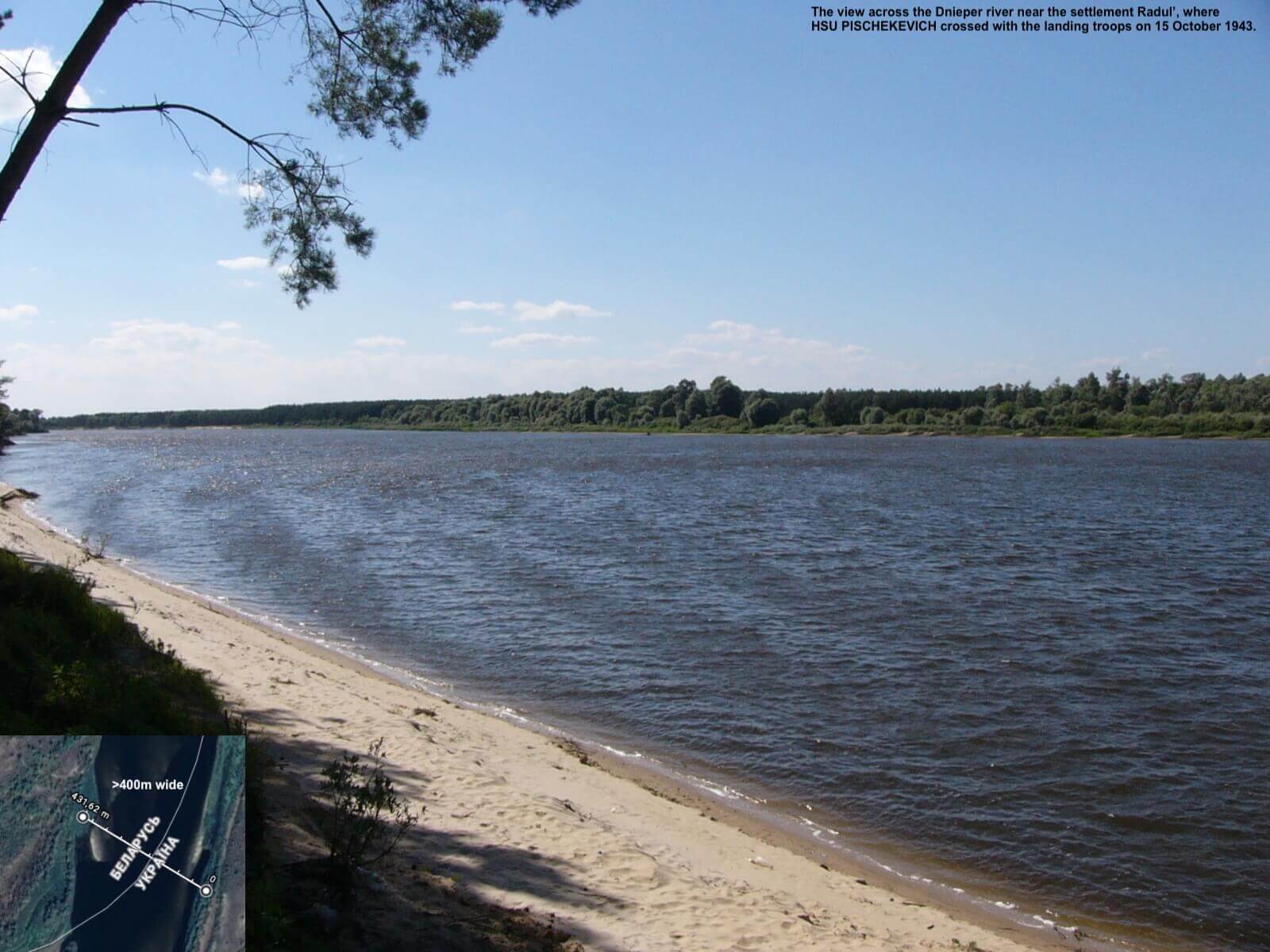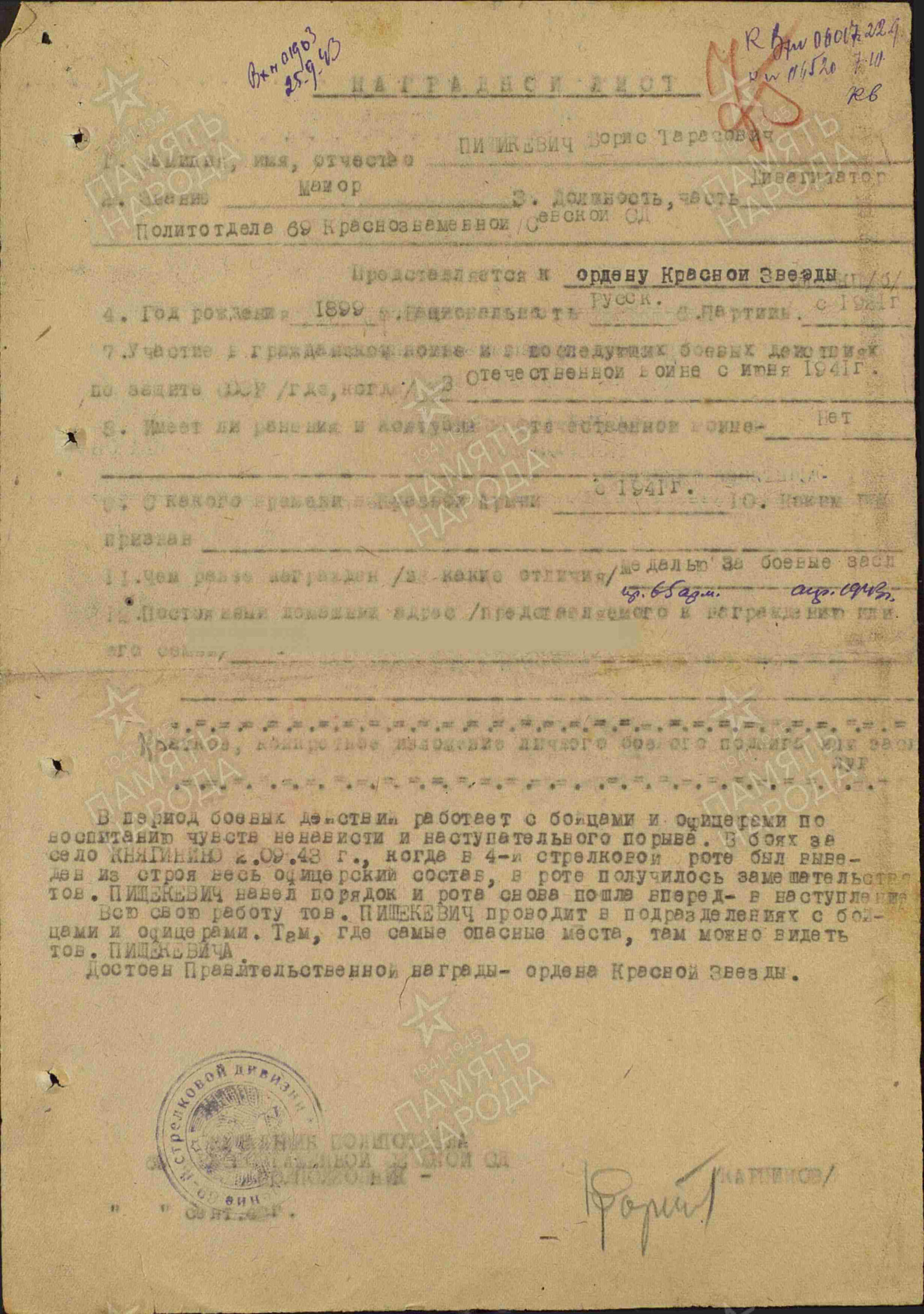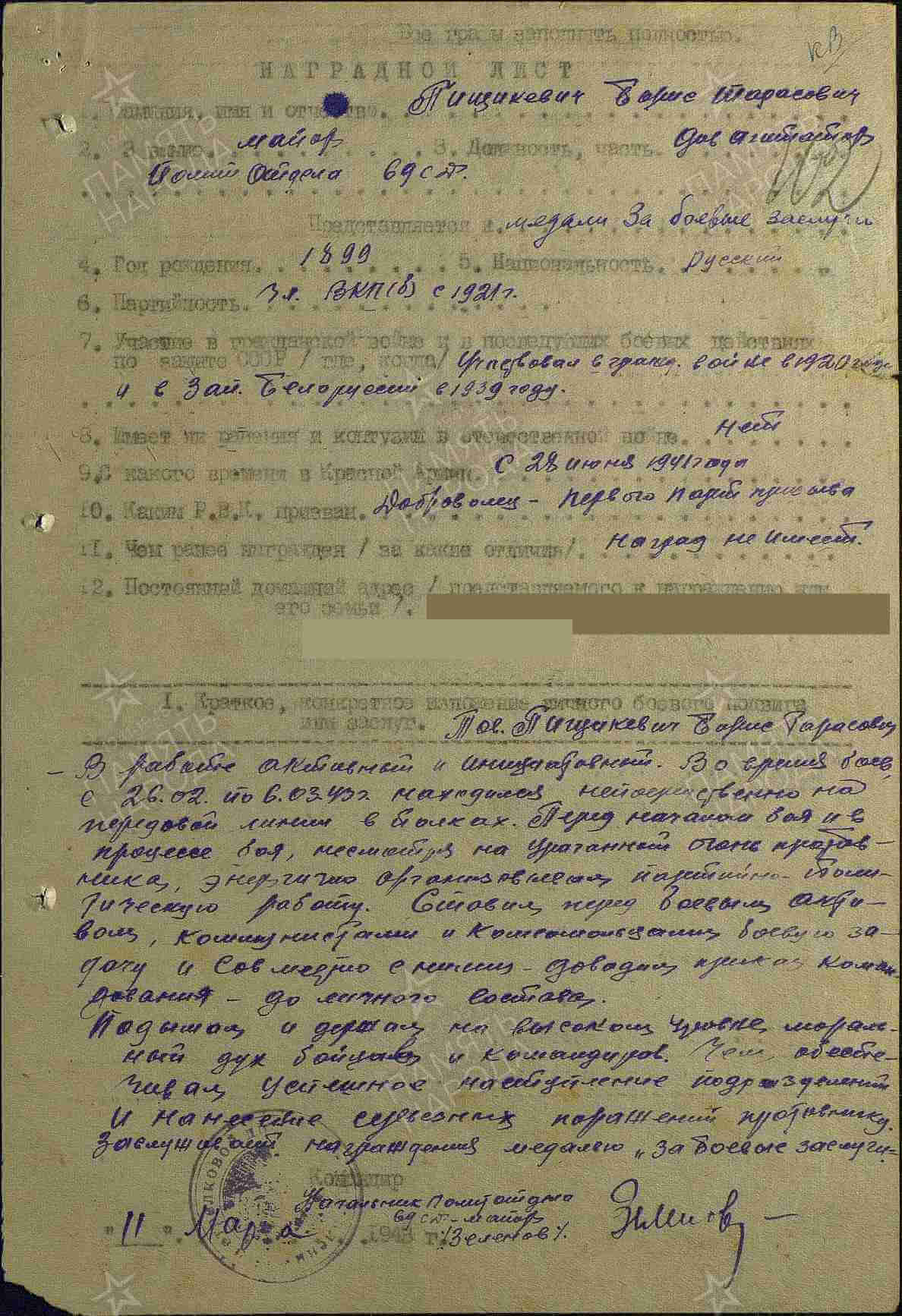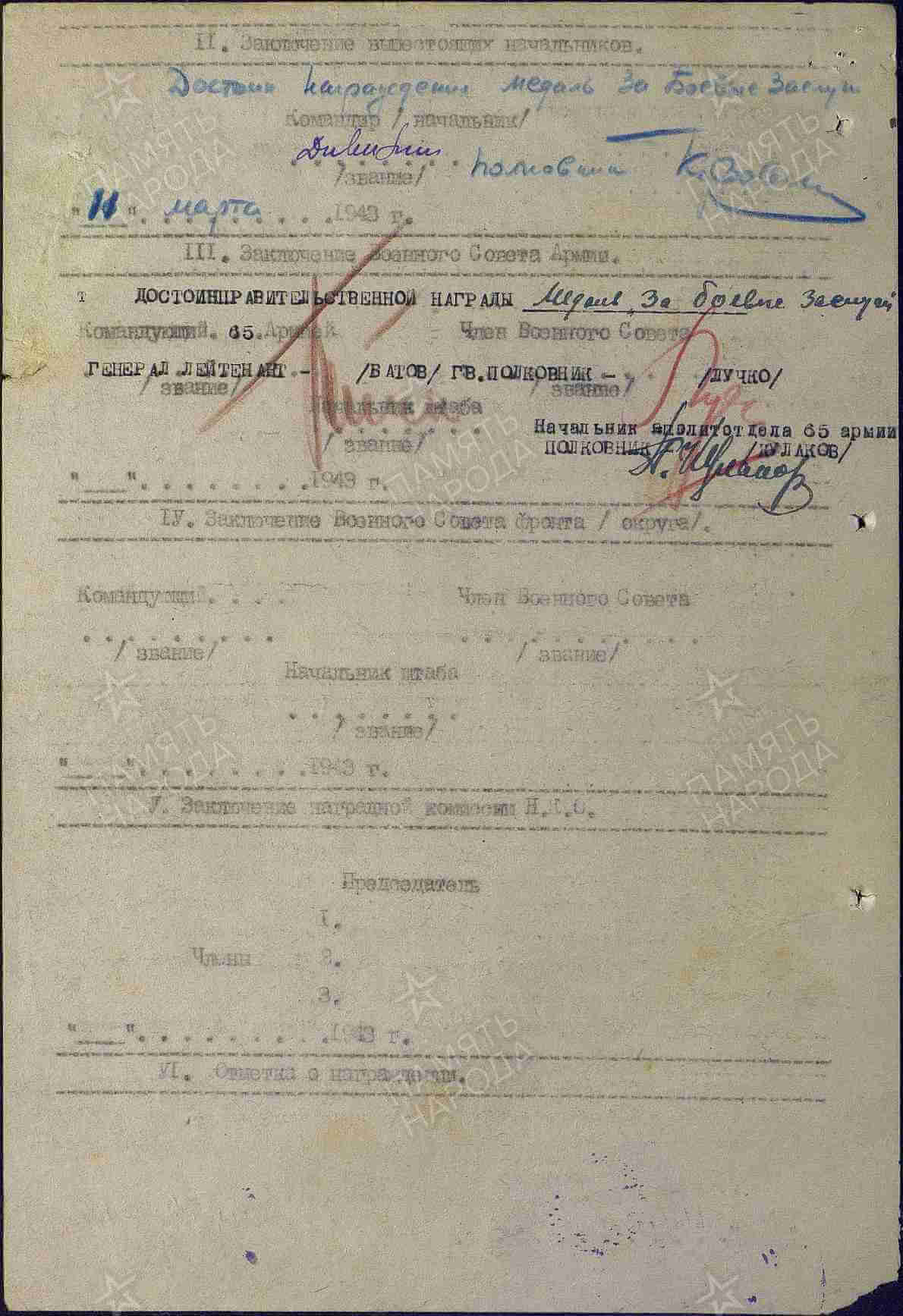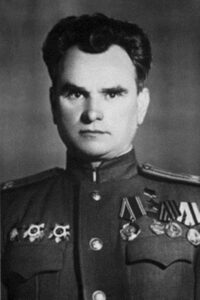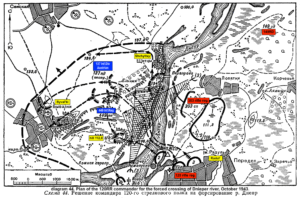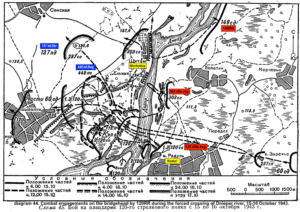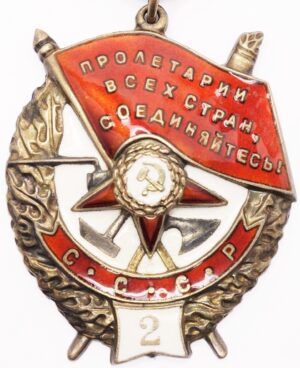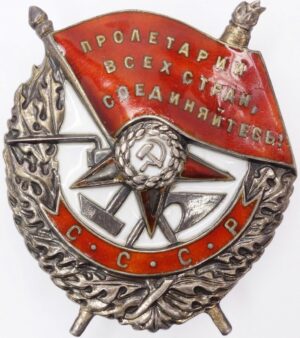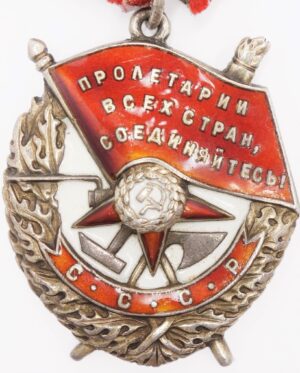Description
Soviet Group to a Hero of the Soviet Union
Awarded to Major Boris Tarasovich Pischikevich (Борис Тарасович Пищикевич)
Awarded for defending the bridgehead, fending off 5 enemy counterattacks, clearing the enemy trenches and replacing the wounded commissar
Rare transitional piece with he gold star struck with the first die and a suspension of the second variation
This group consists of the following items:
- Gold Star to the Hero of the Soviet Union #1586
- Order of Lenin #16008
- Order of the Red Star #296518
- Medal for Combat Merit #215647
- Order of the Badge of Honor #272076
- Replacement award booklet
- Several personal documents including some with his original picture
Gold Star to the Hero of the Soviet Union #1586
Made of 23 ct gold. Measures 32.58 mm in height including the eyelet and 30.38 mm in width. It weighs 19.6 grams not including the suspension. The suspension measures 26.13 mm in width and 21.89 mm in height at its narrowest point.
This gold star is in pristine condition with crisp details and sharp edges. Even the tips of the star have virtually no wear which is quite unusual considering the star is made of pure gold. The lettering is very well defined and its eyelet has the original full thickness on top. Both sides show few contact marks only ad all parts are original. Including the screwplate, suspension, hexagonal plate and the rectangle plate. Its connection ring has not been cut and the long screw has not been shortened. The original ribbon is extremely well preserved since it is covered by a protective plastic cover.
This rare ‘transitional’ piece was produced with the same stamp as the stars with the early suspension. The most noticeable difference is the spacing between the C’s in CCCP. Unlike the later types the distance between the 1st and 2nd ‘C’ is larger than the space between the 2nd and 3rd ‘C’. Only a couple of hundred pieces would fit the criteria for this transitional variation.
Order of Lenin #16008
Made of 23 ct gold, platinum and enamels. Measures 42.58 mm in height including the eyelet, 38.52 mm in width and weighs 33.2 grams without its suspension.
This original order is in superb, far above average condition for an early suspension variation. Its details are all perfectly crisp and even the higher laying parts of Lenin’s face show virtually no wear. Its enamels are without repairs and very well preserved and shows a minuscule superficial chip on the hammer and sickle, barely visible with the naked eye. The reverse is in great condition too with few dings and scratches only. Its connection ring has not been cut and its suspension and ribbon are original to the order.
Order of the Red Star #296518
Made of silver and enamels. Measures 42.58 mm in height, 38.53 mm in width and weighs 27.1 grams without its screwplate.
In excellent, well above average condition. Its details are crisp and the higher laying parts on the soldier show light wear only. The enamels are beautiful and without repairs with a minor superficial chip on tip of the 3 o’clock ray only. The reverse is in excellent condition too and shows an appealing dark patina. The screwpost is full length and the order comes with its time period silver screwplate.
Medal for Combat Merit #215647
Made of solid silver and red lacquer. Measures 32.20 mm in diameter and 2.67 mm in thickness. The height of the medal measures 37.04 mm (including the eyelet) and it weighs 21.1 grams without its suspension. The silver suspension measures 25.54 mm in width at its narrowest part and 31.57 at its widest point.
The medal is in excellent, well about average condition with few small dings and scratches and light wear on its higher laying parts only. Almost all of the the red lacquer filling the lettering is still present. The silver suspension is original as is the brass screw, the nut, the plate holding the red ribbon and the screw tightening it all up. Its connection ring has not been cut and there have been no repairs.
Order of the Badge of Honor #272076
Made of silver and enamels. Measures 49.77 mm in height, 32.74 mm in width and weighs 32.0 grams without its suspension.
The order is in pristine condition with crisp details and flawless enamels. All of the gold plating is still present and its connection ring has not been cut. The order comes with its original suspension and ribbon.
Documents
The accompanying documents are all of Major Pischikevich and included an official replacement order booklet, invitations to the Kremlin, IDs, and work booklets.
An amazing group of great historical significance and impossible to upgrade condition wise!
Citation for the Title of Hero of the Soviet Union:
“On 15.10.1943, comrade PISCHIKEVICH was a part of the landing party (2nd rifle battalion) of the 120 rifle regiment and crossed to the western bank of the Dnieper river and took control of a bridgehead. Together with the landing party, comrade PISCHIKEVICH participated in defending the bridgehead against the enemy counterattacks. His conduct in the battle was brave and he inspired the other men for the combat feats.
During the battle, the landing party commander commissar Lt. Colonel SIDOROV was wounded and taken out of action. Comrade PISCHIKEVICH replaced the wounded commissar and continued the political work among the troops inspiring the Communists and Komsomol members for the combat feats. During 15.10.1943, the landing party fended off 5 enemy counterattacks. After having cleared the enemy trenches, the landing party fortified and fulfilled the combat objective by keeping the bridgehead.
For the exhibited courage and bravery exhibited in the forced crossing of the Dnieper river, comrade PISCHIKEVICH deserves the highest state sward – title “HERO OF SOVIET UNION”.”
The full translation can be read below:
Citation for the Red Star:
“Mj. PISCHEKEVICH, the political commissar of 69 rifle division.
Recommendation for order “RED STAR”
During the combat operations, he worked among the officer corps and the enlisted men, developing in them the feeling of hatred towards the enemy and offensive spirit. In the combat engagements for the village KNYAGININO on 02.09.1943, the 4th rifle company found itself left without any officers as they all were taken out of action. The company troops were in confusion. Comrade PISCHIKEVICH restored the order among the troops and the company continued its attack.
Comrade PISCHIKEVICH spends all his working time among the fighting troops. Comrade PISCHIKEVICH is always present on the most decisive and dangerous sectors of the front.
He deserves the order of the “RED STAR”.”
Citation for the Medal for Combat Merit:
“Mj. PISCHIKEVICH, the political commissar of 69 rifle division.
Recommendation for medal “FOR COMBAT MERITS”.
He is active and energetic in his assignments. In the combat operations during the period 26.02 – 06.03.1943, he was present directly on the front line in the regiment formations. Before and during the engagements, he energetically conducted his Communist-political work, despite intensive enemy fire. He inspired and delivered the combat orders to the active troops, the Communists, and the Komsomol members, and then together with them propagated these combat orders to the rest of the troops.
He improved and kept maintain high combat moral of the fighting troops, which assisted our troops in their advance and in inflicting sever losses to the enemy.
He deserves medal “FOR COMBAT MERITS”.”
More info about Hero of the Soviet Union Major Pischikevich can be found here, here and here
Also included in the picture gallery is the combat diary of the 69th Rifle Division in October 1943, a map of the bridgehead of 16th-17th October 1943 and an infosheet
Major Pischikevich is mentioned several times in the memoirs of general Pavel Ivanovich Batov “On the marches and in battles” 1974. His actions are described in a special book used as training material by the Red Army as one of the exemplary operations. Translations of the relevant parts can be read below:
Original in Russian:
“В походах и боях”, 1974
Автор: Батов Павел Иванович
http://militera.lib.ru/memo/russian/batov/06.html
——————————————————————————–
Book:
“On the marches and in battles” from the military memoirs series, 1974.
author: general BATOV Pavel Ivanovich (1897-1985)
http://militera.lib.ru/memo/russian/batov/06.html
——————————————————————————–
[page 343]
…
On the main sector of advance, the sector covered by 18 rifle corps (18RC), the success of the 69 rifle division (69RD) was clear from the first minutes. Landing troops of the 2nd batt. of 120 rifle regiment (120RR) set sail in an organized manner from the bank. The landing troops were led on the first voyage by the battalion commander Cpt. I.Z.KULESHOV himself, the political A.V.SIDOROV, and by the deputy head of the political department of the division B.T. PISCHIKEVICH.
…
[page 344]
The river itself was still calm. A light wind was blowing, and the smoke screen, placed from the island, successfully covered the boats. The enemy began shelling when they were already near the western shore. The boats responded with automatic and machine-gun fire. Captain KULESHOV radioed for artillery support. At our observation post, the radios were tuned to the waves of divisional and corps radio stations.
– “I give artillery fire! .. I support … Do not hesitate to disembark!” – the voices of IVANOV and KUZOVKOV were heard on the air.
At the same moment, the corps artillery and divisional artillery hit the enemy trenches in the sector in front of the landing troops of 69RD. Commander VESKY ordered his rocket launchers squadron to fire a salvo. This was the second artillery preparation along the front line of the German defence. A ten-minute artillery attack weakened the enemy’s resistance. All the boats of KULESHOV’s battalion approached the shore almost simultaneously. The first to enter the right bank were the scouts of Sgt. P.M.PAKHOMOV from the reconnaissance company (Petr Mikhailovich PAKHOMOV was later awarded the title of Hero of the Soviet Union for this feat). The troops landed and immediately attacked the German outposts, knocked them out of the trench and began to move towards the coastal heights. And the river was already crossed by boats of the second wave. The division commander was in a hurry, while it was still not quite dawn, to build up the forces fighting for the bridgehead. From the hills at the settlement Shchyttsy, the enemy is about to begin aimed shooting at the river, and then it will be difficult to cross. The landing troops of the 303 rifle regiment (303RR) came under concentrated enemy fire. KUZOVKOV ordered the forward battalion of this regiment to be transported to the BAKHMETYEV’s sector.
The battle across the river flared up. Desperately cruel, as happens during such landing battles. After some time, the proper troops governance, headquarters and unit formations will be reestablished on the bridgehead. But in the first hours after the landing, everything is decided by the valour and skill of those few people who clung to the shore.
– KUZOVKOV, who is already on the other side?
– “Two battalions of the 120RR and up to a company of 303RR. Standing their ground. The enemy fires from Shchyttsy.
– How is KULESHOV’s troops doing?
– He’s great. Already advanced by half a kilometre from the river.
[page 345]
– Is there a radio connection?
– It was on the river, now it has stopped. Something happened to them. We are pulling now a wire across the river.
– I believe in Cpt. KULESHOV. He will hold on. And you think how to resolve the problem with the enemy in Shchyttsy. As long as the Germans hold that position, there will be no good. Report later your decision.
According to the plan, the 303RR was assigned to capture the village of Shchyttsy. His landing party could not do anything yet. Lt.Col. MALONOG Grigory Filippovich, one of the heroes of the crossing of the Dnieper, wrote to me later: “The Nazis were stunned by the blow of our artillery and aviation, but by the time the first wave crossed the river, they had time to come to their senses and put up stubborn resistance. Especially in the settlement Shchyttsy, which was located at a dominant height directly near the Dnieper. I saw, that the Germans clearly understood the strategical importance of Shchyttsy, the enemy had all hope for them. I saw for myself, how heavy the battles were here: the whole field was covered with the dead, the trenches and communication passages were clogged with corpses and seriously wounded fascists. The spearhead battalion of the 303RR also suffered heavy losses. But then, the battalion did everything it could. Few survived, but a small bridgehead south of Shchyttsy was held.”
Lt.Col. MALONOG did not write anything about himself, although his military glory is connected with the 303RR. A modest staff officer, he suddenly showed a commanding grip in the operation on the bridgehead. The reader will learn about this later. And now another testimony of a participant in the first landing wave, battery commander BUTYLKIN Viktor Vasilievich. He acted in Cpt. KULESHOV’S landing force as a representative of the 2nd artillery squadron of the 118 artillery regiment. By the way, here is an example of organising interaction in units of the 69RD: the second division, which supported the 120RR. Together they marched hundreds of kilometres in battle. Together they crossed the rivers Sev and the Desna, fought on the river Sozh bridgeheads, and they came to the Dnieper united by experience, personal friendship and faith in each other.
V.V. BUTYLKIN recalls:
“… The entire section of the river was covered in smoke. There is a tense silence in the boat. Only the heavy breathing of the rowers. At the bow, the machine gunner prepared to fire. Next to me is Corporal KOLODIY with his radio. Now we were half way across the river, a German machine-gun opened fire. The shell exploded. “Come on, faster, guys!” – the lead sapper shouted to the rowers. More explosions nearby. The neighbouring boat is sinking. Our boats are firing back. [page 346] “The Radio, comrade commander!” – it was shattered by a shell fragment. Signalman KOLODIP is covered in his blood, but he does not feel wounds, the main trouble is how to be without a radio station. Explosions of our shells hit the shore. Feels better. People jump into the water and run forward. The hand grenades were thrown in one salvoe. The mighty figure of Cpt. KULESHOV is leading the way. Crouching down, he fires his sub-machine gun on the run. We kicked the Germans out of the first trench. Then, rushed into the second one. The Nazis abandoned their positions. Our comrades were so carried away by the pursuit that the battalion commander had to stop them and return them a little back. “We bit off as much as we can chew … Dig in! ” – ordered Cpt. KULESHOV. Soldiers dug the personal ditches and straightened trenches. They knew, they have to hold the ground by themselves all the time until the nightfall. Someone dragged in a prisoner. He was put it in a boat and sent to the other side. And so the German counterattacks began. To correct our artillery fire, I only had some flares left. We had to call in artillery fire, at the risk of falling under it ourselves, since the enemy was very close to us. Everyone who could hold a weapon fought off the Germans. We repelled more than twenty counterattacks on that day.”
The intensity of the battle for the bridgehead is well reflected in the memoirs of the political department officer of the 69RD, B.T. PISCHIKEVICH (I already mentioned that he was the political officer of the 120RR). This courageous political officer, who understands the nature of landing combat, deserved the title of the Hero of Soviet Union in the crossing of the Dnieper. Party political work on the battlefield is of great importance. In a landing operation, the role of party influence on the detachments fighting moral increases many times over. The landing troops, acting according to the “grab and hold” rule, experience extreme physical and psychological stress, a swift attack is replaced by stubborn battles on the defensive, where everyone has to fight as a dozen of men until the main forces come from across the river. At such moments, a Communist political officer leading by personnel example is especially important, his living words, his ability to step in and help … The political officer of the regiment, Lt.Col. SIDOROV, inspiring people, was in the spearhead of the attack. Covering each other with fire, they climbed a twenty-meter slope, threw grenades at the Germans and broke into the second trench. The fended off the first [page 347] enemy counterattack. The Lt. TIMOFEEV platoon rose up and rushed to pursue the enemy. At this point, commissar Lt.Col. SIDOROV was wounded. He fired a long burst at the fascists and shouted before collapsing unconscious: “Guys, go ahead, faster!”.
Comrade PISCHIKEVICH recalls: “The bridgehead captured by the assault detachments was a tiny patch 800 wide and 500 meters deep. It had to be kept. And the Nazis, after the first confusion from our sudden strike, opened heavy fire and cut us off from the left bank … Soon the radio communication with the division commander was broken, which was periodically maintained by Cpt. I.M. PYATKOVSKY. The movement of our boats across the river was suspended. It was then, that the Nazis made a desperate attempt to throw us back into the river; Counterattacks followed one after another. The seriously wounded comrades were immediately provided with medical assistance by the lieutenant-medic OVSYANNIKOV and the medical instructor Ksenia RUBTSOVA. The ranks of the bridgehead defenders were melting, but their spirit was high. “We will die, but we will not retreat” – the soldiers said. We said that the main thing is to hold out until dark: we were not forgotten, the whole division hopes for us, and when night falls, reinforcements will come, ammunition will be brought in … The tension reached the limit. Another counterattack. But our troops fought without taking a single step backwards. Only in the sector west of our dugout headquarters did the enemy manage to push us back. Telephone communication with the companies was interrupted, the radios were out of order. Medical instructor RUBTSOVA ran into the dugout: “Comrades, are we encircled by Fascists?” Every one of us, signalmen, messengers, even wounded and exhausted Lt.Col. SIDOROV, scattered along the trench with sub-machine guns, rifles and grenades and opened fire on the Nazis. The enemy had to seek cover and then retreated. The Nazi counterattack was repulsed along the entire half-ring of the bridgehead without us taking a single step. Only to the west of our dugout headquarters did the enemy manage to push us back. Telephone communication with the companies was interrupted, the walkie-talkies were out of order. Medical instructor Rubtsova ran into the dugout: “Comrades, are we surrounded by fascists?” Every one of us – signalmen, messengers, even Lieutenant Colonel Sidorov, exhausted from loss of blood – scattered along the trench with machine guns, rifles and grenades and opened fire on the Nazis. They lay down and then retreated.
The spearhead battalions of the 69RD were fighting on the western bank of the Dnieper, and the landing troops of ORLOV’S 149RD still could not launch the boats. “The enemy barages the entire sector of the 149th division with heavy fire” – reported officer GORBIN staring into the stereo sights. “Yes, the spearhead battalions are dug in and seek cover on the shore, suffering senseless [pages 348] losses. You won’t get across the river here now.” I /i.e. BATOV/ call the commander to the radio: “Now, move ORLOV’S 149RD to the second line. At night, they will be utilising the crossings of their left neighbor, i.e. 69RD.”
Original in Russian:
Форсирование 120-м стрелковым полком р. Днепр в районе м. Радуль (15–16 октября 1943 г.)
http://militera.lib.ru/science/boy_strelkovyh_podrazdeleniy/33.html
——————————————————————————–
Forced crossing of the Dnieper river by 120 rifle regiment near the settlement Radul’ (15–16 October 1943)
http://militera.lib.ru/science/boy_strelkovyh_podrazdeleniy/33.html
——————————————————————————–
Forced crossing of the Dnieper river by 120 rifle regiment near the settlement Radul’ (15–16 October 1943)
The situation and tasks of the regiment
(diagram 44)
The 69th Rifle Division (120th, 237th and 303rd Rifle Regiments) in the autumn of 1943, during the fighting to clear the left bank of the Dnieper from the enemy, was withdrawn to the second echelon of the corps and after a short rest was instructed to start combat training. In the first days of October, the division, having made a 30-kilometer march, concentrated in the Lopatni area, m. Radul, x. District, where she began to prepare for the crossing of the Dnieper and the breakthrough of the enemy’s defenses on the right bank.
By decision of the corps commander, the 69th Rifle Division was supposed to force the Dnieper on the morning of October 15 in the Shchyttsy sector, mark 106.8, capture a bridgehead on the right bank in the Shchyttsy, Byvalki area and ensure the crossing of the remaining formations and parts of the corps to the captured bridgehead. With the beginning of the offensive of the main forces of the corps on the right bank, the 69th division was assigned the task of covering the left flank of the corps from possible enemy counterattacks from the southwest.
On October 9, the division commander with the commanders of rifle regiments and reinforcement units conducted a reconnaissance of the zone of the upcoming offensive of the division from the points prepared at a height of 111.3 and on the northwestern outskirts of Cape Radul. At the end of the reconnaissance, the division commander announced his decision, in which he indicated that the division, reinforced by the 218th mortar regiment, with the support of the corps and army artillery groups, would cross the Dnieper with the task of seizing the bridgehead and ensuring the crossing of the rest of the formations and parts of the corps. The battle formation of a division for forcing is built in two echelons. In the first echelon – the 120th and 303rd regiments and in the second – the 237th regiment. Regiments of the first echelon should start crossing the Dnieper at the same time. The crossing will be covered by a smokescreen.[204]
After that, the division commander assigned the following tasks to the regiments of the first echelon:
303rd Regiment – to cross the Dnieper west of Lopatnya, having the immediate task of capturing Hill 134.5, subsequently, in cooperation with the neighbor on the right, to take Shchyttsy and advance to Hill 130.6;
The 120th regiment was to cross the Dnieper from a small island, northwest of Cape Radul, having the immediate task of capturing the height of 112.0, subsequently reaching the area of an unnamed height southwest of Elnik and developing an offensive on Byvalki.
The division commander pointed out to the regimental commanders that one reinforced rifle battalion should be sent from each regiment of the first echelon on the first flight.
The 237th regiment (the second echelon of the division) was supposed to cross after the 303rd regiment and develop its success in the direction of Senskaya.
From the information received at the headquarters of the 55th division, parts of which defended the left bank of the Dnieper, the commander of the 120th regiment knew only general information about the enemy, namely, that units of the 137th infantry division, manned mainly the Austrians. Enemy subunits in the indicated sector are supported by three to four artillery battalions of various calibers.
The enemy’s defense on the left bank consisted of two discontinuous trenches of a full profile and separate trenches, interconnected by communications. The first trench ran 50-70 meters from the water’s edge and was occupied by enemy outposts. The second trench, which the units of the 55th division defending on the left bank considered the front line of the enemy’s defense, ran along the eastern outskirts of Shchitsa, the eastern slopes of height 134.5, an unnamed height west of Elnik, height 139.8, the eastern outskirts of Byvalka. Cells for shooters, platforms for light and heavy machine guns were prepared in the trenches. Near the trenches for shelter and recreation of personnel, the enemy had dugouts. The strongholds were prepared in the Shchyttsy area, at an unnamed height west of Elnik, and in the Byvalki area.
According to the artillery reconnaissance of the 55th division, it was known that up to the division of 150-mm howitzers of the enemy fired from the Senskaya area, that a battery of 105-mm guns was located west of Byvalka, and in the Byvalka area – up to the division of 75-mm and 105-mm guns.
It was established by observation that the enemy was strenuously fortifying his positions. In particular, it was noted that local residents under escort were dismantling houses in the villages of Shchyttsy and Byvalki and dragging logs to the front line. The regiment commander also knew that in the zone of the forthcoming offensive of the regiment, the width of the Dnieper reaches 350-400 m, and the depth – 6-9 m. To the west of Cape Radul on the Dnieper there are two islands – small and large, covered with shrubs. [206]
The left bank of the Dnieper on the site of the lake. Holy, m. Radul – sandy, open. Only the settlements of Lopatni, m. Radul and Kh. could serve as shelters for our troops. District.
The western coast in this area rises 20 m above the eastern coast. This allowed the enemy to view our coast to a depth of 5–8 km.
The decision of the commander of the 120th regiment and preparation for forcing
The commander of the 120th regiment, Colonel Bakhmetyev I.A., having comprehensively studied and considered the mission of the regiment, as well as the forces and means that would provide forcing, during the reconnaissance announced to the commanders of the battalions and units assigned to the regiment his decision, in which he indicated that the first flight to The 2nd rifle battalion, reinforced by a company of anti-tank rifles, a foot reconnaissance platoon and one 45-mm gun, will begin the crossing on 25 fishing boats.
The battalion was given the task of destroying the enemy outposts in the area of the 106.8 mark, capturing the 112.0 hill, gaining a foothold there and ensuring the crossing of the main forces of the regiment.
The regiment commander ordered the 1st battalion, under the cover of the 2nd battalion, to cross over to the right bank by the second flight, turn around from behind the right flank of the 2nd battalion and, in cooperation with it, seize the nameless height west of Yelnik.
Together with the 1st battalion, all regimental and battalion artillery was to be transported.
After the crossing of the 3rd battalion to the right bank, it was planned to strike Byvalki with a strike by the 1st and 3rd battalions, where, having entrenched, to ensure the crossing of the main forces of the division, preventing possible enemy counterattacks from the southeast.
To distract the enemy’s attention from the actual crossing points of the regiment, it was decided to organize a false crossing from the large island in the direction of Byvalki, where earlier units of the 55th division had repeatedly tried to cross to the right bank. For this purpose, one platoon from the 3rd battalion with four boats was allocated. The platoon was supposed to start the demonstrative crossing 20 minutes before the 2nd battalion began crossing the river.
The crossing of the 2nd battalion from the large island in the direction of mark 106.8 was covered by a smoke screen. It was decided to install a smoke screen with the beginning of the artillery fire raid.
To ensure the crossing of the first echelon of the regiment, three heavy machine guns and two 45-mm guns were installed on the big island, which had the task of conducting flanking fire in the direction of mark 106.8 and height 134.5; three heavy machine guns were located west of Lopatnya for flanking fire at a height of 112.0. [207]
The regiment commander demanded from the commander of the 2nd battalion that the subunits that were crossing were able to fire rifles and machine guns at the enemy from boats.
To ensure forcing and combat on the opposite bank, a regimental artillery group was created as part of the 1st and 2nd divisions of the 118th artillery regiment of the division, which had twelve 76-mm guns and six 122-mm howitzers.
In addition, the regiment was supported by a howitzer artillery brigade and a guards mortar regiment (M-8). Taking into account the attached and supporting funds, the regiment had 67 guns and mortars per 1 km of the front.
Artillery preparation for forcing and attacking on the right bank was carried out according to the division’s plan. Artillery preparation was designed for 40 minutes and began with a volley of guards mortars on Shchyttsy, height 112.0 and an unnamed height west of Yelnik. This was followed by a 5-minute fire raid by the entire artillery of the division along the first trench and then methodical fire along the front line and the discovered firing points.
Regimental and battalion artillery received the task of firing direct fire at the detected enemy firing points in the area of marks 106.8 and 112.0.
The commander of the 120th regiment knew from the division commander that before the start of the crossing and during the battle on the western bank of the Dnieper, strikes by our attack and bomber aircraft were envisaged against the front line of the enemy’s defense and in the areas of Senskaya, Byvalki.
After clarifying some issues on the interaction between battalions and reinforcements, the regiment commander ordered the battalion commanders to complete the preparation of units and crossing facilities for crossing the Dnieper in the afternoon of October 14. On the night of October 15, the 2nd battalion with subunits was supposed to take its starting position for crossing on a small island. On the night of October 15, the 1st and 3rd battalions were ordered to concentrate on the northwestern outskirts of Cape Radul in readiness to force the Dnieper.
The 120th Rifle Regiment was incompletely manned by the beginning of the crossing. He was armed with ten heavy machine guns, ten anti-tank rifles, twelve 82-mm mortars, four 120-mm mortars, six 45-mm and two regimental 76-mm guns. Rifle companies were armed with 50% rifles and 50% machine guns.
It should be noted that the personnel of the regiment, with the exception of the replenishment that arrived (20%), had rich combat experience, in particular in forcing rivers. During the offensive battles of 1943, the regiment crossed the Desna, Snov and Sozh rivers.
The regiment had four days to prepare for the crossing. During this time, reconnaissance was carried out at the link of the regiment – battalion and interaction was organized; the units were replenished with ammunition, the condition of the crossing [208] means was checked and the calculation for the crossing was made, and several training sessions were held with personnel on boarding and disembarking from the crossing facilities.
Within three days, subdivisions and divisional sappers assigned from each battalion assembled and repaired 25 fishing boats with a carrying capacity of 8 to 15 people each in coastal settlements. In addition, the division allocated part of the crossing facilities to the regiment. Each boat was equipped with a platform for firing from a light machine gun. The boats had spare oars, scoops for pouring water, wooden wedges, rags for patching up holes, and two or three 5-6-meter ropes to save people in case of serious damage to neighboring boats.
The regiment was greatly assisted by the population of the town of Radul, which before the war was mainly engaged in river fishing and knew the Dnieper well. 15 residents of the Radul borough expressed their desire to be ferrymen.
On the night of October 10, the 2nd battalion replaced units of the 55th division on the northern outskirts of Cape Radul, and on the night of October 11, one company of the 1st battalion replaced units of the same division on the big island. On October 11, in the backwaters of the Dnieper northwest of Cape Radul, training of units of the 2nd battalion began together with ferrymen. During training, all boats were numbered and assigned to the battalion units. In one trip on 25 boats, it was possible to transport 240 people, three heavy machine guns, six anti-tank rifles, four 82-mm mortars and one 45-mm gun.
The commander of the regiment, Colonel Bakhmetyev, his deputy for political affairs, Lieutenant Colonel Sidorov, and the commander of the 2nd Battalion, Captain Kuleshov, spent three nights training units of the 2nd Battalion in boarding boats, moving boats to the western coast, and the ability to fire machine guns and rifles from boats, a quick landing from boats and an organized attack by the enemy on the right bank.
On the night of October 14, the division commander held a lesson with the 2nd battalion in the old channel of the Dnieper, between Cape Radul and the big island. The lesson was held 600–700 m from the enemy, who had been harassing rifle and machine-gun fire all night. The lesson gave a good result – the fighters acted boldly and confidently during the crossing.
On the afternoon of October 14, the regimental commander received a written combat order from the division commander to force. After that, he summoned the commanders of battalions and divisions to his observation post (300 m northwest of Cape Radul), clarified with them once again the combat mission of the regiment and each battalion on the ground, checked the degree of development of interaction issues. The commander of the 2nd battalion received an order to withdraw the battalion to its original position for crossing by 4 o’clock on October 15. [209]
Battle progress
On the night of October 14-15, the enemy behaved calmly not only in front of the front of the 120th regiment, but also in the entire zone of the division. Occasionally, single rifle shots were heard from the outpost trench, from time to time the river bed was illuminated by rockets. It was clear that the enemy did not detect the concentration and preparation of our troops to force the Dnieper.
By 4 o’clock on October 15, the 2nd battalion took up its original position. Captain Kuleshov warned the company commanders about the need for the strictest observance of camouflage measures and ordered the boats to be sheltered, and the subunits to dig in 5-10 meters from the shore.
As soon as it began to dawn, a platoon of the 3rd battalion began a demonstration of forcing from a large island in the direction of Byvalka. At the same time, Guards rocket launchers fired a volley along the front line of the enemy’s defense, and artillery preparation began on a wide front. A few minutes later, our assault and bomber aircraft struck at the front line and enemy artillery firing positions in the Senskaya and Byvalki areas.
The 2nd battalion in an organized manner, with all units, boarded the boats and set sail from the shore. A weak wind blew to the northeast, so the smoke screen raised from the large island successfully covered the battalion’s crossing. When no more than 50 m remained to the right bank, the enemy discovered the battalion and fired at it from rifles and machine guns. Captain Kuleshov ordered the return rifle and machine-gun fire from the boats on the trenches of the outposts and speed up the movement. Firing from machine guns, machine guns and rifles, all the boats of the 2nd battalion approached the shore almost simultaneously. The companies quickly landed and on the move attacked the trench in which the enemy’s outposts were located. As a result of a short battle, the battalion destroyed the outposts, occupied the trench and began to move towards height 112.0.
Simultaneously with the 2nd battalion, the battalion of the neighboring 303rd regiment also began crossing in the direction of the southern outskirts of Shchitsa. However, the situation here developed unfavorably, since after a volley of guards mortars in the village of Shchittsy, a fire broke out, which illuminated the entire section of the crossing of the 303rd regiment. As a result, the battalion, having set sail from the eastern shore, immediately came under strong enemy rifle-machine-gun and mortar fire and, having suffered heavy losses, was forced to return. Further attempts by the 303rd regiment to resume the crossing in this area throughout the day were unsuccessful, since the Nazis kept the mirror of the river and the eastern bank in the area of the crossing under fire.
The 2nd Battalion of the 120th Regiment, having destroyed the enemy’s outposts, continued to advance towards Hill 112.0 in combat, simultaneously expanding [210] the captured bridgehead along the coast to the north and south. Acting boldly and decisively, our soldiers and officers showed examples of perseverance and courage in this battle.
The deputy commander of the battalion for the combat unit, Captain Shakhov, with a group of soldiers, destroyed the calculation of a heavy machine gun, the fire of which blocked the company’s path of advance. Senior Sergeant Pasteluk in an unequal battle with hand grenades and machine gun fire destroyed eight Nazis. The battalion commander, Captain Kuleshov, and the deputy regiment commander, Lieutenant Colonel Sidorov, who crossed over with the battalion, were all the time in the combat formations of the units and appeared in a timely manner where their leadership was required by the situation.
As a result of a four-hour battle, by 12 o’clock the 2nd battalion reached the western slopes of height 112.0, expanding the bridgehead along the front to 4 km.
The 1st battalion crossed on the second flight in the same boats. During this voyage, a telephone connection was established across the river. By 10 o’clock, the 1st battalion, having landed on the right bank, turned to the right of the 2nd battalion, which by this time continued to fight on the western slopes of height 112.0.
Having completed the immediate task, the crossing units of the 120th regiment tried to further expand the captured bridgehead, but their further advance towards the nameless height was stopped by strong barrage fire from mortars, artillery and organized enemy machine-gun fire from the nameless height.
After the crossing of the 1st battalion on the way back, most of the boats were disabled by enemy artillery fire, so the crossing of the regimental artillery and the 3rd battalion was delayed until the evening.
At 12 o’clock on October 15, the enemy opened heavy artillery and mortar fire on the units that had landed on the bridgehead, and groups of 30-50 soldiers began to launch one counterattack after another. In just one day of the battle, the regiment’s units repulsed up to 25 such counterattacks on the bridgehead. Reflecting counterattacks, the battalions of the regiment at the same time sought to expand the bridgehead along the front and in depth.
It should be noted that in this battle the platoon and company commanders managed their units well and acted wisely and boldly. So, for example, Lieutenant Timofeev’s platoon, advancing on the southwestern slopes of an unnamed height, duly entrenched itself at the reached line and, having let the enemy counterattack group up to 100–150 m, opened salvo fire from rifles and machine guns at it. In a short time, most of the soldiers of the counterattacking group were exterminated, and the survivors, under the influence of organized fire, were forced to drop their weapons and flee. Then Lieutenant Timofeev raised a platoon to attack and captured a new advantageous line, where he entrenched himself. [212]
The regiment commander directed the battle of the battalions from the left bank until the evening. Radio and wire communications with the battalions operated without interruption.
By the end of the day, the enemy stopped counterattacks, and the units of the regiment entrenched themselves in the captured bridgehead. During the day, the regiment, in a tense battle for the bridgehead, destroyed more than a hundred enemy soldiers and officers, captured several prisoners and trophies – 4 mortars, 6 machine guns, 3 radio stations. The divisions of the regiment on the bridgehead lost 40 people killed and wounded during the day of the battle. The prisoners captured by the regiment belonged to the 449th regiment of the 137th infantry division. During interrogation, they testified that their regiment had received orders to stubbornly defend the western bank of the river in the Byvalka area, in addition, they knew that the division was supposed to spend the winter at this line. They knew nothing about the preparation of the offensive of our troops.
With the onset of darkness and during the night of October 16, the crossing of the 3rd battalion, battalion and regimental artillery and other units of the regiment continued. The regiment commander moved his observation post to the right bank in the region of height 112.0.
In addition, on the same night, the 303rd and 237th rifle regiments of the division crossed over the crossing of the 120th regiment to the western bank of the Dnieper.
On the morning of October 16, after a 5-minute artillery raid on the front line of the enemy’s defense, the 120th regiment, holding the line west of height 112.0 with the 2nd battalion, went on the offensive to an unnamed height; The 303rd regiment developed an offensive on the southern outskirts of Shchitsa. After capturing the nameless height, the 237th regiment was brought into battle from behind the right flank of the 120th regiment with the task of capturing the height of 130.6.
With artillery and mortar fire, the enemy tried to delay our advancing battalions. At 11 o’clock the 4th company of the 2nd battalion at a height of 112.0 was subjected to a heavy fire raid of artillery and mortars. Under the cover of this fire, two groups of enemy infantry, 40-50 people each, simultaneously launched a counterattack from the west and south. The 4th company let the enemy in at close range, and then with organized rifle-machine-gun fire and hand grenades fell on the counterattacking groups. The enemy retreated, leaving many dead on the slopes of the height.
The 1st and 3rd battalions persistently continued their attacks on an unnamed height. By 2 p.m., having broken the resistance, they captured it, after which they turned to the west and, overcoming enemy fire resistance, approached the northeastern outskirts of Byvalka.
The 303rd regiment attacked Shchyttsy through Elnik, cleared this point of the enemy, and by the end of the day captured height 137.0; By the same time, the 237th regiment had captured height 130.6. [213]
By the end of the day on October 16, the 69th division captured a bridgehead of about 40 square meters on the western coast. km and, firmly entrenched on it, ensured the crossing of corps units and other army formations to the right bank.
On October 17, the 120th regiment, interacting with neighboring units, drove the enemy out of Byvalka and in the afternoon of October 17 was withdrawn to the reserve of the division commander.
* * *
The 120th regiment completed the task assigned to it. The success of the battle was achieved thanks to the well-organized preparation of units for crossing, the covert concentration of the 2nd battalion at the crossing points, and the organized conduct of the first and subsequent flights. Of great importance were the bold and reasonable actions of the units on the right bank, and the successfully placed smoke screen to cover the crossing of the 2nd battalion also helped. An important role was played by the demonstration of a false crossing in the area to which the attention of the enemy was riveted.
Please contact us with questions
